#scuffles 1991
Text





Sergei embarrasses Smyth - Wings @ Nordiques - Oct. 19, 1991
#detroit red wings#hockeytown#hockey#sergei fedorov#mickey redmond#shawn burr#wings 1991#fights#hockey fights#red wings#fights 1991#scuffles#scuffles 1991#october 1991#october 19th 1991#detroitredwings#brad mccrimmon
13 notes
·
View notes
Text
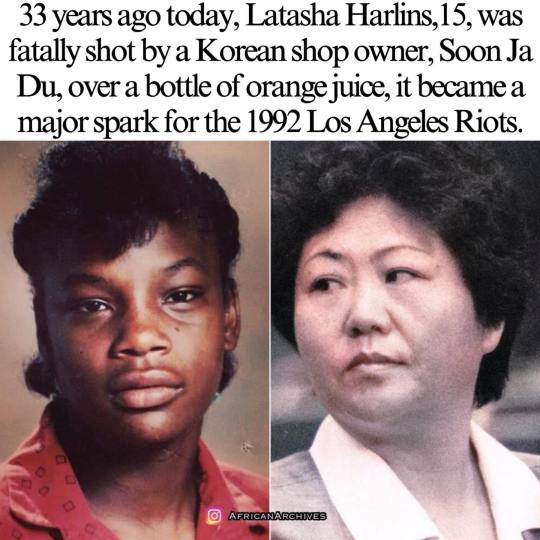
On March 16, 1991 Latasha Harlin’s short life came to a violent end in the midst of racial tensions in LA, and became a major spark for the 1992 Los Angeles Riots.
By the late 1980s, racial tensions were high in South Los Angeles.
After the change in national immigration laws in 1965 a large number of Korean immigrants arrived in Los Angeles and by 1968 the first Korean-owned market opened in South Central LA.
Longtime African American residents in the area at first welcomed the Koreans but eventually grew angry with them because they refused to hire black employees and often treated their customers poorly.
By 1990, 65% of South Central businesses were Korean-owned and a 1992 survey of these storeowners revealed considerable racial prejudice against black customers and black people in general.
Koreans in response argued that their attitudes evolved from high crime rates in the area and shop owner fears of shootings and burglaries. Latasha Harlins became a victim of these racial tensions on the morning of Saturday, March 16, 1991.
She entered a store owned by a Korean family, to purchase a bottle of orange juice. As she approached the counter, Soon Ja Du, accused her of stealing after seeing her place the bottle in her backpack, despite her holding the $2 payment approaching the counter to pay.
Du grabbed the bag and the two women had a violent scuffle. Harlins threw the juice bottle back on the counter and turned to leave the store when Du pulled a .38-caliber handgun and shot 15-year-old Harlins in the back of the head.
Du was arrested and her trial was held on November 15, 1991. Security-camera footage which showed Harlins’ attempt to pay for the juice and the subsequent scuffle between the two women convinced a jury to find Du guilty of voluntary manslaughter.
The Judge, Joyce Karlin, rejected the jury’s recommendation and instead sentenced Du to five years probation, 400 hours of community service, and a $500 fine.
One of the many reasons black people don't f*** with Asians like that and we should collectively drive them out of our neighborhoods
#latasha harlins#los angeles riots#racial tensions#korean immigrants#south los angeles#soon ja du#racial prejudice#voluntary manslaughter#racial discrimination#asian anti blackness#asian racism
267 notes
·
View notes
Text
Ok I’ve decided I’m gonna hop on the tournament bandwagon so here I go!
Hello, and welcome to The Gay Disney Games, where we pit creations of the homophobic company against each other to see who gives off the most queer vibes. I’m planning to hold a few different tournaments over the summer, but the one I’m planning to start with is…
What is the most queer-coded Disney movie?
Rules:
It’s not just gay vibes! Anything under the lgbtq umbrella is good! (ie. Mulan being trans coded)
Only Disney and Pixar movies! So no Marvel or Star Wars or whatever else
No bigotry of any kind- especially homophobia, transphobia, or aphobia (this is an lgbtq tourney it’s an all or nothing deal)
Sequels and remakes are able to be submitted, but the spot will likely go to whichever movie in the franchise received the most submission
Beauty and the Beast (1991) is already in, since it’s what inspired me to make the tournament, so you don’t have to submit it!
Submissions Form
Tagging for exposure: @who-do-i-know-this-man @tnt-tourney @character-of-all-time @handsomestwomantournament @autismxadhdtournament @autismswagsummit @sea-animal-bracket @stem-sister-scuffle @mfshipbracket @fuckingstupidbracket @ultimate-word-tournament @ultimate-blorbo-bracket @tournament-winners-tournament @bestanimatedmovie @the-queer-classic-lit-ship-ever @the-nobody-tournament @worlds-worst-dad-competition
and for good measure @tournamentdirectory
234 notes
·
View notes
Text
Duo: An appreciation
Let's talk about Duo, the bizarre spaceman of the Megaman series. Duo debuted in 1996 with Megaman 2: The Power Fighters. Duo was however, conceived in late 1995 when development on Megaman: The Power Battle was beginning to wrap up. A sequel was already decided on and Capcom's arcade division wanted the sequel to add in elements they didn't have time to implement such as support units and rescuing Roll. They wanted to further give this arcade game its own identity by introducing a character exclusive to it. This character was envisioned originally as deliberately being a farcry from the Classic Megaman design conventions established up to that point: A character that would fight using traditional kick and punches as opposed to firing projectiles or charging at the enemy. This also applied to his design which originally were more human seeming than any of the Classic robots sans Roll. He would be towering at 3 meters tall and could detect signals using the red jewel on his ushanka.
The original design prompt was simple: He would be a character with the flavor of "Russia" in mind. This was because Duo was intended to be Dr. Cossack's (from Megaman 4 (1991)) own creation. This very concept was said to have blown away series veterans Keiji Inafune and Hayato Kaji when they first glimpsed the concept art.

Eventually Kaji (designer for Megaman/Rockman X, Bass/Forte, Treble/Gospel and X3's Nightmare Police) took what existed and gave an updated design that had a more overt Russian influence. Apart from the ushanka, the Russian wrestler archetype was done away in favour of something inspired by USSR militsiya while tastefully mixed with robotic elements that give the appearance of being constructed with spare parts.
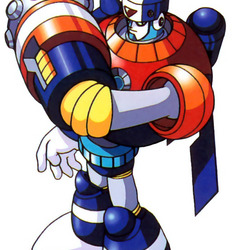
While the design was finalised, the character's background wasn't. Taking inspiration from Astroganger (1972), Keiji Inafune insisted to change Duo's story and to use him in the upcoming Megaman 8 (1996). This way, there would be a extra incentive to play Power Fighters in order to learn more about MM8.
This new story instead reimagined Duo as something of a small time law enforcer for a unknown intergalactic organisation who fell to Earth chasing a criminal hosting a malevolent energy source. Duo himself is imbued with his own energy that helps nullify evil energies and sense people's energy. Because of this, he can sense the justice that lies in people such as Rock and even Bass. This is clearly based off Astroganger's plot of a wicked energy source falling to the peaceful Earth and Astroganger himself being a hollow mass of energy inside his metal shell.

This change of background to tie in with 8 ended up causing some confusion between the Arcade division and the Rockman team at Capcom. This is seen in how Duo's victory lines in Power Fighters (that were muted in international releases) have him boast about protecting the "motherland" and telling his enemies to calm down. Duo in TPF is depicted as a more relaxed and calm man compared to the justice zealot that 8 and especially other media adaptations portray him as. He comes close to realizing Protoman's connection to Megaman, and believes Bass has potential to do good, seeing the latter's threats as mere puff. Duo's bgm by Masato Kouda also reflects the difference in character, as he pointed out that his theme was composed based on first impressions rather than knowledge of the role he would play in MM8. His theme in TPF leans close to contemporary Japanese New Jack Swing and RnB than the traditional superhero anthem reminiscent of 70s anime Duo would be associated with in MM8 and Battle n Chase.
Megaman 8 tells the story of how he met Megaman and company, after being repaired by Dr. Light from his crash landing. After a brief scuffle, Duo befriends Megaman and even rescues him when he is infected by the evil energy, he leaves to find the other evil energy but asks Protoman to tell Megaman his gratitude.

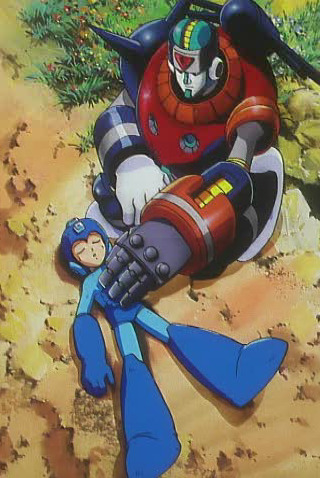
Duo would later appear as a special unlockable character in the racing spin off Battle n Chase having the strongest stats. He was originally available by a JP-only event, but was unlockable in the game in later re-releases and international releases.

Duo later appeared as a CD in Megaman and Bass (1998) and hasn't made any major appearance since. Dr. Cossack would eventually have his own major creation, the non-canon and underwhelming OVER-1 in Rockman X-OVER (2011) who shares design elements with Duo and X.
Duo was also re-imagined in the Battle Network series with the 4th game released in late 2003. Here, he is instead a judge-like figure who destroys planets he deems to be pure evil. It is only through Hub fighting him that he decides Earth to still be salvageable. His design was changed to be even more larger and with a neutral colour scheme to give a image of a placid stone faced judge.

Past all that, Duo in the original Megaman series serves a unique purpose that many other characters in the franchise failed miserably at. A attempt at a design type that would be deemed "unconventional" yet also fits with what has been established. This logic was also used for the Deep Log triplets for Rockman X DiVE in recent times but as we can see, they feel like insults to Megaman.

Duo, unlike Droitclair, Erato and Angiedjeedkcnnjcwekofofeecw has a unique purpose. His designers wanted him to stand out while still paying respects to the MM world which was almost 10 years old, the idea of parallel justice (a phrase often used in MM8 marketing material alongside "ultimate justice") and that somewhere out there, there is someone else who cares about everlasting peace just as much as Megaman is a great and substantial idea. He is essentially what a more adult Rock could be like. Duo should not be a recurring character at all but his existence no matter how surreal and bizarre adds a subtle depth to the original Megaman series. During the period of 1994-1998, Classic Megaman was trying to expand itself more and more and a concept as daring as Duo's, like the other ideas brought forth then, is a painful reminder of how lazy current day Capcom is with every facet of the series and proven with how disastrous the results of blindly replicating the same philosophy has been.
#megaman#rockman#duo#long post#I want to do more write ups like this in the future#“just say you want him to shag you and go”
67 notes
·
View notes
Text
Queer Protest Photos
Content Warnings: HIV/AIDS, homophobia, medical violence against intersex people, use of a slur in an organization’s name
Finally found some time to actually select and compile the ones I wanted to include in this post. I have well over 200 pictures I’ve digitally collected over a span of approximately 5 years. I’ll try to include some information (when possible) about each one as well!
(2 important notes: information is only that which I have been able to verify, therefore dates or locations may be omitted. As well the genders of people in the photos is assumed for the descriptions.)
A Die-In, San Francisco. Date currently unverified

(Photo description: A black and white photo of several people lying on a city street as if they’re dead. In the front is a man holding a sign with a triangle and the slogan “Silence = Death”, behind him is another man with an unreadable sign, in the middle is a large coffin which says “110,000 Deaths”)
Die-ins were a common form of protest during the AIDS Crisis in which groups of people would gather and lay down in public places as if they were dead. This is a picture of one which occurred in San Francisco most likely in the 1980’s.
ACT-UP Protest, Grand Central Terminal, NYC. Jan. 24, 1991

(Photo Description: A colour photo taken from below of two men standing on a train station timetable sign. They are hanging a black and white sign with a small red border which reads “One AIDS Death Every 8 Minutes”. The sign is partially obscured by one of the men)
ACT-UP, or the Aids Coalition to Unleash Power, was a prominent political organization working to bring an end to the AIDS epidemic. This photo was taken during the placement of a large banner at Grand Central Terminal in New York City bringing awareness to the fact that at this time there was approximately one death from AIDS every 8 minutes.
People of Colour Mobilizing Against AIDS. April 1st, 1989
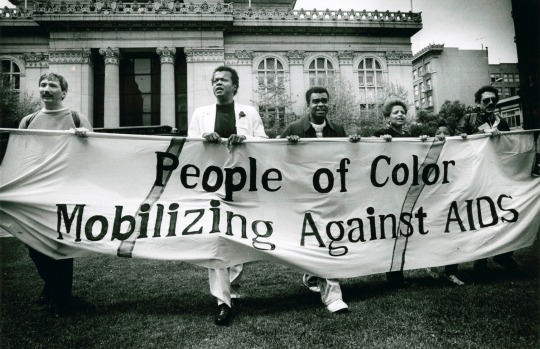
(Photo Description: A black and white photo of 6 people holding up a very large black and white banner which reads “People of Color Mobilizing Against AIDS”, the banner has grey stripes on it. There are 2 men of unknown ethnicity on wither side of the banner, in the middle are two black men and 2 black women. One of the black women is almost entirely hidden behind the banner with only the top half of her face showing)
Likely taken at a college campus. Often photos surrounding AIDS protests leave out one of the groups most vulnerable to AIDS: people of colour. I think this photo is an amazing reminder that people of colour were a massive part of the fight to end AIDS
The Stonewall Riots, NYC. June 28, 1969
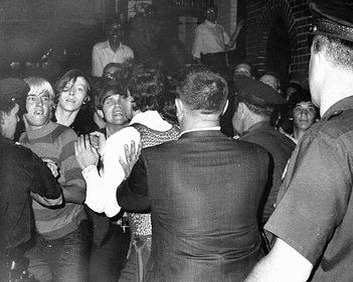
(Photo Description: A black and white photo of several teenage boys and young men scuffling with men in suits and police officers. The photo is crowded with people. The boys at the front are being pushed back by the police officers)
This is the only known photo taken of the riots at the Stonewall Inn. It was taken on the first day of the riots by Joseph Ambrosini. It shows the chaos that occurred during the police raid on The Stonewall Inn.
Notable Queer Activists At A March. Date and location not currently verified.

(Photo description: a black and white photo of people walking down a city street. Some of them are holding signs. There’s an older woman with light curly hair and a man with short dark hair and a large mustache in the front. They’re talking to each other and the man is holding a white cassette recorder. They’re wearing black shirts with triangles and the slogan “Silence = Death”)
This is a photo most likely taken in the late 1980’s of notable queer activist Connie Norman. I’ve seen the person beside her referenced as being Robert Birch but I have yet to find a young photo of him in order to verify. In the background another notable gay activist (although he was unfortunately also a NAMBLA activist) Harry Hay can be seen. This photo was taken at an AIDS protest.
Mother and Son, San Francisco. June, 1984

(Photo Description: a black and white photo of an African American mother and son embracing each other. The son has an armband with a feather. He is also wearing a rolled bandana around his head with a flower tucked into it. )
This photo is believed to have been taken by Joan E. Biren. While it’s not what’s often imagined when one thinks of a “protest photo”, this photo was taken at a 1984 Pride march which was certainly a protest. The people in this picture were members of a queer marching band called Sistah Boom. The people on the photo are often referenced as mother and son but whether that’s true I do not know.
Men Embracing At AIDS March, NYC. August 12, 1984

(Photo Description: A black and white photo of two men standing in front of a group of people marching. The group has 3 signs with slogans. One is unreadable, the others say “Stop AIDS Not Gays” and “Fight AIDS Not Gays”. The two men in front are both wearing black trench coats and one has his arm wrapped around the other’s waist. They’re facing away from the camera)
This photo is interesting because it appears on the New York City AIDS Memorial. This photo was taken as a protest surrounding the AIDS Crisis and I think that the inclusion of the men embracing makes it incredibly heartwarming.
A Father Holding A Sign, Westchester, New York. September 12, 1974
<Warning! Brief mention of homophobic violence!>

(Photo Description: A black and white photo of an older man in a suit holding a large handmade sign which reads “I’m proud of my gay son”. He is standing in front of a crowd of people. There is a banner being held by members of the crowd in the background which reads “Gay Liberation of Westchester”. )
This photo was taken at a Gay Liberation March in 1974. It shows Dick Ashworth marching in defense of his son. This photo was taken shortly after the formation of Parents of Gays which later became FLAG or P-FLAG. This photo was taken shortly after the son of the found of Parents of Gays was beaten in a homophobic attack.
The First Modern Intersex Protest, Boston, MA. October 26, 1996
(Content Warning: Brief mention of forced surgery on intersex people, use of a slur in the name of an organization)
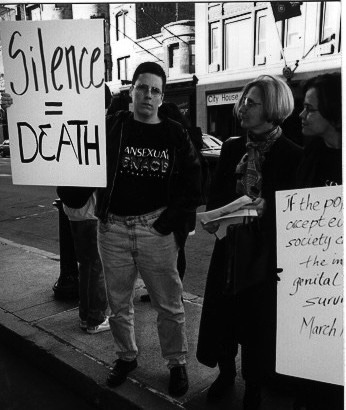
(Photo Description: a black and white photo of people standing on a traffic island in the middles of the road holding signs. There is a man with short dark hair and glasses holding a sign which reads “Silence = Death”. Next to him are two women. The background contains light coloured buildings)
This photo contains intersex advocate Max Beck at the first ever modern protest for intersex rights. Max Beck is a notable intersex advocate who’s sex was indeterminate at birth but forced to undergo surgery and was raised as a female . This photo was taken at a protest organized by Hermaphrodites With Attitude, an organization which sought to end the human rights violations against intersex people. This photo means a lot to me personally as an intersex person.
I have so many more I wish I could show but for the sake of the length of this post I’ll only include one more. The most famous by far…
If I Die Of Aids…, 1988

(Photo Description: A colour photo taken from behind of a man wearing a custom painted dark coloured jacket. A finger partially obscures the picture. The back of the jacket reads “If I die of AIDS — Forget burial — Just drop my body on the steps of the F.D.A”, behind the text is a large pink triangle)
You almost certainly have seen this photo before but you may not know the story behind it. This picture was taken of queer artist David Wojnarowicz during a protest in 1988 regarding the F.D.A’s failure to properly handle the AIDS crisis. David Wojnarowicz had been diagnosed with HIV only one year prior to this photo being taken.
This isn’t even scratching the surface. I have so many more pics that include many many different types of queer people and subject matters. I wish I could share all of my photos and maybe I’ll make more posts like this in the future. I’ll see how this one does before I make any promises.
And to all my queers out there: stay safe. I love you. We’re family. Take care of yourself, if not for you than for our ancestors in these photos. And for the sake of taking more photos which will one day be considered “queer history”. We have always been here and we will always be here even if people try to break our spirit. 🏳️🌈🏳️⚧️❤️🧡💛💚🩵💙💜🌸🌼🌺🪻
#gay#mlm#queer#trans#lgbt#lgbtq#lgbtqia#lgbt history#lgbtq history#pride#hiv/aids#wlw#lesbian#bi#pan#pansexual#bisexual#transgender#cw homophobia#cw aids#long post
9 notes
·
View notes
Text

The Severed Finger & The Disappearance of Diane Augat
The last time that 40-year-old Diane Augat was seen was on the 10th of April, 1998. She had been at her sister’s home in Hudson, Florida, when her sister went to a doctor’s appointment. When she arrived back home, Diane was gone.
Later that day, Diane was seen at the Hay Loft tavern at Little Road and State Road 52. The barman told Diane that he wouldn’t serve her because she was walking in circles and was presumably intoxicated.
Diane was reported missing by her mother, Mildred, and investigators launched a search for her. Mildred told investigators that her daughter had a bad habit of trusting strangers, and she had suffered from mental illnesses. Mildred feared that somebody had taken advantage of her daughter’s trusting nature.
Diane had been missing from almost a week when Mildred’s phone began to ring. At the time, Mildred hadn’t been home, but the caller had left a voicemail. When Mildred clicked play, she was stunned to hear her daughter’s voice. She fear in Diane’s voice was audible as she screamed: “Help – let me out!” There was then a scuffling sound as though somebody was grabbing the phone from Diane’s hands. The line then went dead.
The number on the Caller ID box said that the call had come from something called Starlight. Mildred attempted to call the number back but nobody ever picked up. “I think she knew who she was with,” Mildred said.
Less than 24 hours later, somebody was walking along the side of U.S. 19 near New York Avenue when they spotted something on the floor. Looking closer, they recoiled in horror to see that it was a human’s finger, with a red painted nail. The finger was identified via fingerprints as belonging to Diane.
With tears in her eyes, Mildred said: “She is in trouble. Big trouble. They’re probably torturing her.” She said that she feared that whoever had cut off her daughter’s finger was going to continue harming her until she was dead. “I’m hoping that she’s still alive, that they haven’t killed her yet…” she said.
The gruesome find meant that investigators had a specific area to focus their search on. The Pasco County Sheriff’s Office called in a helicopter which scanned the area, but there was no other evidence of Diane. Sheriff’s spokesman Jon Powers stated: “Our case has to include the possibility of foul play.” He then added that they were considering other scenarios as well in which Diane could have somehow lost her finger accidentally and was still alive.
Investigators appealed to the public, and asked everybody to keep a look out for Diane, and if they knew anything about her whereabouts to get in contact.
For years, Diane’s life had been in a downward spiral. Years beforehand, her life had focused on her three children and her husband, Frederic Augat, who ran an assisted living facility in Land O’Lakes. Her sister, Denise, recollected: “She had $100 pocketbooks. She was pretty. There could be 1,000 people in the room, and you’d notice her.” But then in the late 1980s, Diane was diagnosed with manic depression. She was on medication, but still, Diane struggled. In 1998, prosecutors had filed child abuse charges against Diane. She was eventually acquitted of the charges, but further complaints were lodged against her by the Department of Children and Families. Eventually, Diane lost custody of her children. Child protective services believed that Diane was suffering from Munchausen by proxy syndrome, which led her to seek excessive and unnecessary medical treatment for one of her children.
In 1991, Diane and Frederic divorced, and he was granted full custody of their three children. Diane was left distraught, and her life began to unravel rapidly. Her mother recollected: “The crux of her whole mental health issue was losing the children. She put pictures of them on her refrigerator and would look at them and stand there and just cry and cry.”
As a coping mechanism, Diane turned to alcohol. She tried to find company at the local bar, and Mildred feared that she had struck up a conversation with somebody who had nefarious motivations. Diane did not drive, so she either walked, hitchhiked or got rides from friends. This led to fears that Diane could have been abducted. Diane had also stopped taking her medication, and had spent some time in a psychiatric facility. She had been taken into custody under the state’s Baker Act at least 32 times. Under the Baker Act, a judge, police officer or doctor decides whether a person is mentally ill enough to require involuntary confinement.
Less than a week later, convenience store manager Patricia Sblendorio noticed something tucked into the store’s outdoor freezer case. It was a bag of neatly folded clothes. Diane was a frequent patron of the store, so Patricia got in contact with her sister, Deborah Cronin. Deborah identified the bag of clothing as belonging to her sister as she had gifted her some of them.
Investigators were dispatched to the convenience store to recover the bag of clothing and enter it into evidence. Sheriff’s spokesman Kevin Doll said that the clothing could have been placed there by a group of juveniles that often hung out with Diane at her home on Chesapeake Drive in Odessa. Since her disappearance, the group of youths were accused of looting her home.
Eventually, the days turned to weeks, the weeks turned to months and then the months turned to years. Investigators spoke with more than 100 people and followed several leads, but each lead only led to a dead end. Mildred said in 2000: “A part of me is gone. I never accepted she was dead.”
In November of that year, Terry Wilson walked into the Circle K convenience store at 15837 U.S. 19 to purchase some items. She saw a clear, zip-lock plastic bag on top of the lotter corner and decided to pick it up. She walked outside and once inside her car, she examined the bag. The name “Diane” was written in black marker on the bag.
Terry’s heart skipped a beat. Terry was the girlfriend of Diane’s brother. Mildred identified the items in the bag as items her daughter would have owned: black eyeliner, Taboo perfume, and a tube of bright pink lipstick. The discovery offered the family a glimmer of hope that Diane could still be alive. Once again, however, the discovery only led to another dead end.
Over 24 years have passed since Diane Augat was last seen alive. Despite an extensive search, Diane still remains missing today.
7 notes
·
View notes
Photo

The Severed Finger & The Disappearance of Diane Augat
The last time that 40-year-old Diane Augat was seen was on the 10th of April, 1998. She had been at her sister’s home in Hudson, Florida, when her sister went to a doctor’s appointment. When she arrived back home, Diane was gone.
Later that day, Diane was seen at the Hay Loft tavern at Little Road and State Road 52. The barman told Diane that he wouldn’t serve her because she was walking in circles and was presumably intoxicated.
Diane was reported missing by her mother, Mildred, and investigators launched a search for her. Mildred told investigators that her daughter had a bad habit of trusting strangers, and she had suffered from mental illnesses. Mildred feared that somebody had taken advantage of her daughter’s trusting nature.
Diane had been missing from almost a week when Mildred’s phone began to ring. At the time, Mildred hadn’t been home, but the caller had left a voicemail. When Mildred clicked play, she was stunned to hear her daughter’s voice. She fear in Diane’s voice was audible as she screamed: “Help – let me out!” There was then a scuffling sound as though somebody was grabbing the phone from Diane’s hands. The line then went dead.
The number on the Caller ID box said that the call had come from something called Starlight. Mildred attempted to call the number back but nobody ever picked up. “I think she knew who she was with,” Mildred said.
Less than 24 hours later, somebody was walking along the side of U.S. 19 near New York Avenue when they spotted something on the floor. Looking closer, they recoiled in horror to see that it was a human’s finger, with a red painted nail. The finger was identified via fingerprints as belonging to Diane.
With tears in her eyes, Mildred said: “She is in trouble. Big trouble. They’re probably torturing her.” She said that she feared that whoever had cut off her daughter’s finger was going to continue harming her until she was dead. “I’m hoping that she’s still alive, that they haven’t killed her yet…” she said.
The gruesome find meant that investigators had a specific area to focus their search on. The Pasco County Sheriff’s Office called in a helicopter which scanned the area, but there was no other evidence of Diane. Sheriff’s spokesman Jon Powers stated: “Our case has to include the possibility of foul play.” He then added that they were considering other scenarios as well in which Diane could have somehow lost her finger accidentally and was still alive.
Investigators appealed to the public, and asked everybody to keep a look out for Diane, and if they knew anything about her whereabouts to get in contact.
For years, Diane’s life had been in a downward spiral. Years beforehand, her life had focused on her three children and her husband, Frederic Augat, who ran an assisted living facility in Land O’Lakes. Her sister, Denise, recollected: “She had $100 pocketbooks. She was pretty. There could be 1,000 people in the room, and you’d notice her.” But then in the late 1980s, Diane was diagnosed with manic depression. She was on medication, but still, Diane struggled. In 1998, prosecutors had filed child abuse charges against Diane. She was eventually acquitted of the charges, but further complaints were lodged against her by the Department of Children and Families. Eventually, Diane lost custody of her children. Child protective services believed that Diane was suffering from Munchausen by proxy syndrome, which led her to seek excessive and unnecessary medical treatment for one of her children.
In 1991, Diane and Frederic divorced, and he was granted full custody of their three children. Diane was left distraught, and her life began to unravel rapidly. Her mother recollected: “The crux of her whole mental health issue was losing the children. She put pictures of them on her refrigerator and would look at them and stand there and just cry and cry.”
As a coping mechanism, Diane turned to alcohol. She tried to find company at the local bar, and Mildred feared that she had struck up a conversation with somebody who had nefarious motivations. Diane did not drive, so she either walked, hitchhiked or got rides from friends. This led to fears that Diane could have been abducted. Diane had also stopped taking her medication, and had spent some time in a psychiatric facility. She had been taken into custody under the state’s Baker Act at least 32 times. Under the Baker Act, a judge, police officer or doctor decides whether a person is mentally ill enough to require involuntary confinement.
Less than a week later, convenience store manager Patricia Sblendorio noticed something tucked into the store’s outdoor freezer case. It was a bag of neatly folded clothes. Diane was a frequent patron of the store, so Patricia got in contact with her sister, Deborah Cronin. Deborah identified the bag of clothing as belonging to her sister as she had gifted her some of them.
Investigators were dispatched to the convenience store to recover the bag of clothing and enter it into evidence. Sheriff’s spokesman Kevin Doll said that the clothing could have been placed there by a group of juveniles that often hung out with Diane at her home on Chesapeake Drive in Odessa. Since her disappearance, the group of youths were accused of looting her home.
Eventually, the days turned to weeks, the weeks turned to months and then the months turned to years. Investigators spoke with more than 100 people and followed several leads, but each lead only led to a dead end. Mildred said in 2000: “A part of me is gone. I never accepted she was dead.”
In November of that year, Terry Wilson walked into the Circle K convenience store at 15837 U.S. 19 to purchase some items. She saw a clear, zip-lock plastic bag on top of the lotter corner and decided to pick it up. She walked outside and once inside her car, she examined the bag. The name “Diane” was written in black marker on the bag.
Terry’s heart skipped a beat. Terry was the girlfriend of Diane’s brother. Mildred identified the items in the bag as items her daughter would have owned: black eyeliner, Taboo perfume, and a tube of bright pink lipstick. The discovery offered the family a glimmer of hope that Diane could still be alive. Once again, however, the discovery only led to another dead end.
Over 24 years have passed since Diane Augat was last seen alive. Despite an extensive search, Diane still remains missing today.
12 notes
·
View notes
Text

Latasha Harlins (July 14, 1975 - March 16, 1991) whose short life came to a violent end amid racial tensions in Los Angeles, became a major spark for the 1992 Los Angeles Riots. She was born in East St. Louis, Illinois to Crystal Harlins and Vester Acoff Sr. She has a brother and sister.
The family moved from Illinois to South Central Los Angeles when she was six. Her mother was found brutally shot on November 27, 1985. The children’s maternal grandmother, Ruth Harlins raised her and her siblings.
She became a victim of these racial tensions on the morning of Saturday, March 16, 1991. She entered Empire Liquor, which was owned by a Korean family, to purchase a bottle of orange juice. As she approached the counter, Soon Ja Du, one of the storeowners, accused her of stealing after seeing her place the bottle in her backpack, despite her holding the $2 payment for the $1.79 price of the juice and approaching the counter to pay. Du grabbed the bag and the two women had a violent scuffle. She threw the juice bottle back on the counter and turned to leave the store when Du pulled a .38-caliber handgun and shot her in the back of the head.
Du was arrested and her trial was held on November 15, 1991. Security camera footage which showed she attempted to pay for the juice and the subsequent scuffle between the two women convinced a jury to find Du guilty of voluntary manslaughter and call for the maximum 16-year jail sentence. Judge Joyce Karlin, rejected the jury’s recommendation and instead sentenced Du to five years probation, 400 hours of community service, and a $500 fine.
The judge’s decision exacerbated racial tensions between African Americans and Korean immigrants. Du’s store was looted, set on fire, and never reopened. Judge Karlin became a target of numerous protests and stepped down from the bench. The Harlins family received a $300,000 settlement from Du’s insurance company. #africanhistory365 #africanexcellence #blm
0 notes
Text
The Perks of Being a Wallflower: Plot Synopsis
cw// mentions of csa
The Perks of Being a Wallflower is a 2012 coming-of-age film that takes place in Pittsburgh Pennsylvania in 1991. The film follows protagonist Charlie Kelmeckis, an introverted, anxious teenager who, like many adolescents his age, struggles to make friends upon entering his first year of high school. Though not explicitly stated, Charlie’s suffering from depression is alluded to over the course of the film, evident in frequent, worried exchanges between him and close family members.
Charlie eventually befriends two older seniors, step-siblings Sam and Patrick, who take him under his wing, gradually integrating him into their friend group. It was only until this point that Charlie felt like he belonged, genuinely astounded that people cared to pay him any attention. Over the course of the film, Charlie experiences many “firsts” – going to his first party, doing recreational drugs for the first time, and having his first kiss to name a few.
Despite all of these things, Charlie often finds himself troubled by the relationships in his life – specifically the dynamics of these relationships. Charlie learns that his older sister, Candace, is in an abusive relationship with her boyfriend, after witnessing him striking her across the face in the middle of a heated dispute. When Sam reveals that her first kiss happened when she was 11 with an older man, he realizes that she, like his Aunt Helen, had been abused as a child. Charlie also learns that Patrick, who is openly queer, is in a secret relationship with Brad, a closeted football player who pretends to not know him at school.
These observations prompt him to ask his English teacher, Mr. Anderson – whom he develops a strong connection with over the course of the film – “Why do nice people choose the wrong people to date?” to which he responds “We expect the love we think we deserve”.
More hijinks ensue up until Charlie has a brief falling out with his new friend group. Charlie is able to make amends when he saves Patrick from being jumped by Brad and his friends – a scuffle that broke out in response to Brad calling Patrick a slur historically primarily used to refer to gay men. It is through this encounter that Charlie demonstrates that he cares about them, unconditionally.
As his first year of high school comes to a close and all of his senior friends graduate, familiar feelings of loneliness and abandonment threaten to encroach upon his newfound confidence. Things come to a boiling point when Charlie has a severe mental breakdown, of which he blames himself for the death of his Aunt Helen. He is swiftly admitted to a mental facility where he is sent to recover after, what the film alludes to, an attempted suicide. Soon after it is revealed that, unbeknownst to the rest of his family, his aunt had molested him as a child, repeating the cycle of abuse due to her unhealed, repressed trauma.
Charlie continues to write letters in recovery. During this time, he is frequently visited by close family members. He even receives a letter from Sam, who insists that she come visit him at Penn State sometime. Eventually, Sam and Patrick return to Pennsylvania to visit Charlie. The movie concludes with Charlie declaring that he finally feels like he belongs somewhere.
Overall, this movie explores themes of identity and socialization. Charlie learns to explore who he is through navigating new friendships and relationships. This is exemplified in how his growing relationship with Sam and Patrick ultimately help Charlie develop feelings of purpose and self-worth, facets of his personality that were not present at the beginning of the film.
1 note
·
View note
Text

Ira Schirmer
Encrypted Email Exchange
To: Chuck Rhoades
Security: 🔒 Encrypted
Click on the link after you see what I found.
Join Video Meeting
https://video-meeting-us/97877783200?pwd=dQxNUMydVBxbG5yUXvLOFyRFZpQTO9
Video Meeting ID: 6778 7778 3200
Passcode: DXFZJ34lc

YOUNG REPUBLICANS OFFSHOOT HOLDS FIRST EVENT
By Josh Morrison
The most recent registered organization on campus, the Students for Corporate Independence, held its first event last night in Connecticut Hall. The evening opened with remarks from the club’s president Robertson Wycoff ‘93, regarding the club’s interest and mission statement. Wycoff then encouraged members and onlookers to mingle and enjoy refreshments.
Though its name is broad, the Students for Corporate Independence was founded in response to a sole point of contention among the Young Republicans—the issue of apartheid. Members of the young republicans have been split into two camps about the crisis in South Africa, mostly over whether or not the United States should intervene. Campuses across the country have weighed in on the issue, with protests advocating for disinvestment from South African businesses cropping up at Harvard University and Smith College, among others. The Students for Corporate Independence split off from the Young Republicans led by Wycoff refused to support calls for disinvestment at Yale.
Wycoff’s involvement comes as a surprise to some, especially since he is a student-athlete for the lacrosse team. Despite his time commitment to his sport, he has devoted much of his energy to getting the Students for Corporate Independence off the ground, citing his passion for the right to make choices for ourselves.
“Is it segregation? Yes. But is divestment the best way to solve this issue—crippling the economy and threatening the poorest in South Africa’s livelihoods? Not to mention the government’s attempted overreaches to make these choices for corporations,” Wycoff said during the meeting. “The United States had its own stain with segregation—luckily we are long past that being an issue—but any intervention from foreign governments to force integration would have been tantamount to an overthrow.”
Following Wycoff’s speech, new club members dined on snacks from South Africa-based businesses.
“Now this tastes like freedom,” Wycoff quipped. “Democrats are missing out.”

September 13, 1991
Yale Daily News
Page 5
Apartheid Protest Turns Chaotic After Scuffle
By Will O’Donnell
Four students were taken into custody by campus police last night after a peaceful protest against apartheid was met with resistance from counter protesters. Star lacrosse player Robertson Wycoff, president of Students for Corporate Independence and Class of ‘93, organized the counter protest after he heard students would be gathering in front of Commons to call on the Yale board of trustees to divest its endowment from South African businesses and investments.
According to onlookers, protesters held up signs and sang songs in between speeches from student leaders and faculty members. Once Wycoff’s group arrived, however, things quickly escalated, with Wycoff addressing the protesters with a megaphone.
“Wasting your time on a country halfway around the world! Get a job!” he said as he approached the seated protesters. “Or better yet, learn to mind your business.”
“Students were feeling uncomfortable about the counter protesters getting in their faces, and we don’t want anyone feeling unsafe,” Campus Police Chief Matthew Donn said. "Then came the yelling and shoving, so we got involved to settle things down.”
A student who was one of the initial protesters was taken to the infirmary with swelling on the ankle. She was discharged later in the evening.

YALE DAILY NEWS, WEDNESDAY, MARCH [?]
Wycoff Enters YCC Race
By Kevin Adams
Robertson Wycoff (Class of 1993), the firebrand at the helm of the polarizing organization Students for Corporate Independence, announced his intent to run for president of the Yale College Council yesterday morning. Flyers appeared on lampposts and bulletin boards early yesterday touting Wycoff’s run and a kickoff speech in the afternoon. Hundreds of students attended the event, which included an appearance by the Yale lacrosse team and members of the Pom Squad.
“I am proud to announce my run for YCC president, and especially honored to do so with the support of my brothers on the lacrosse team,” Wycoff said. “If I am elected, I will serve every student to the best of my ability, whether they’re dealing with an academic issue or want cooler people to come perform on campus.”
While Wycoff is best known for his play on the field, he has garnered disdain from progressive members of the student body for his leadership in the Students for Corporate Independence, a club against economic sanctions for apartheid South Africa. Earlier this year, he was taken into campus police custody for a fight that broke out during an anti-apartheid protest. Wycoff was later cleared of any wrongdoing.
“To say we disagree only on economic policy is a disservice to the cause,” Maya Albertson, a well-known activist on campus and ‘94, said. “He has more in common with segregationists. Wouldn’t be surprised if he had his own Klan robes.”
Wycoff faces opposition from Charles Rhoades, Jr., a third-year in Saybrook College, and Ramona Blackburn, a member of Trumbull College and ‘93. A debate featuring all the candidates will be held in three weeks.
0 notes
Text





Stevie protects teammate - Wings @ Nordiques - Oct. 19, 1991
#detroit red wings#hockeytown#hockey#steve yzerman#kevin miller#gerard gallant#hockey fights#hockey hits#scuffles 1991#scuffles#bench#bench 1991#wings 1991#detroitredwings#red wings
14 notes
·
View notes
Text
“Four Musketurtles”
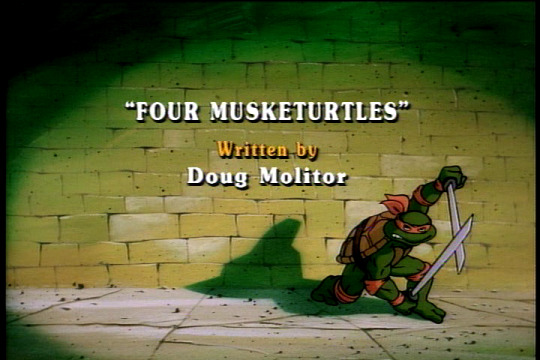
Season 3, Episode 16
First US Airdate: November 9, 1989
First BBC UK broadcast: September 23, 1991
A blow to the head leads to Leonardo losing his memory.
Our long and winding journey through the third season of Teenage Mutant Ninja Turtles continues with "Four Musketurtles". This is the series debut of Doug Molitor, who had previously written for the ABC sitcom Sledge Hammer! and Police Academy: The Animated Series.

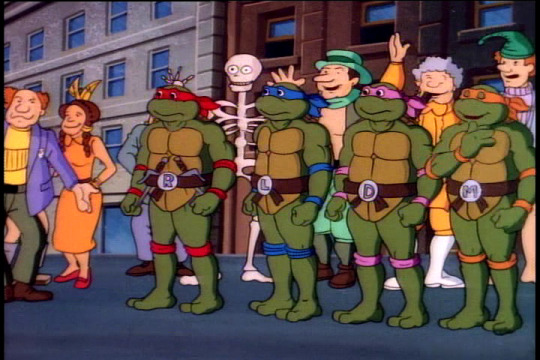
April is reporting from the Mardi Gras parade in front of an array of costumed partygoers. Some interesting designs on display from the outset here, including a superhero with a camel head, a Ninja Turtles enthusiast and a LITERAL SKELETON.

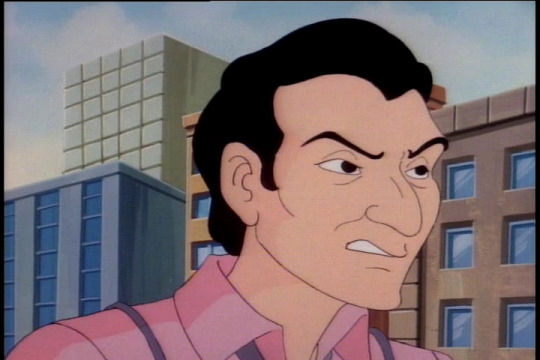

Not in costume but in attendance anyway are the real Turtles, who are enjoying the opportunity to wander around and not arouse suspicion. Raphael and Vernon bicker about who’s uglier before April shoos her co-worker away. She explains to the Turtles that her costume is that of a 17th century noblewoman, the kind that would appear in the novel The Three Musketeers. The Turtles don’t get the reference, and April provides them with a copy she just happens to have on her.

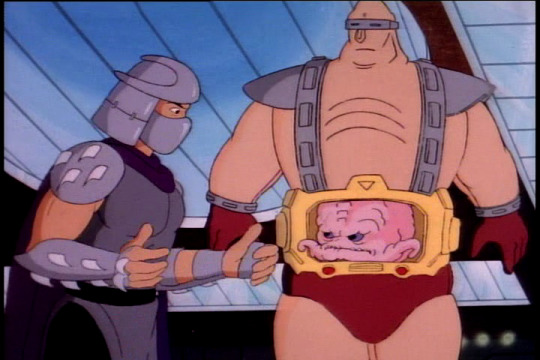
Krang watches April’s next report, which is sponsored by a jeweller. She reveals that they found “the priceless Star of Brazil diamond”, which was recovered in Earth’s deepest mine. Krang tells Shredder it’s actually Impervium, “the lost element of Dimension X” and now we bear witness to something even more precious – a TMNT lore flashback!
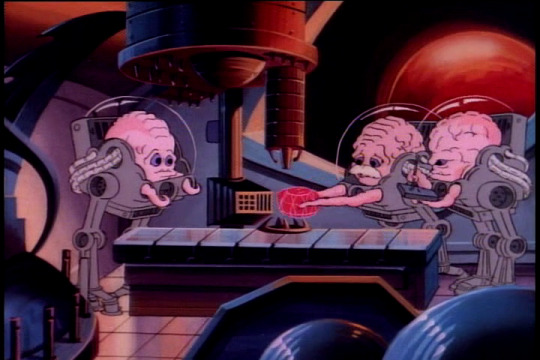
Three bodyless brains in walkers – one bizarrely sporting a moustache, the other two looking identical to Krang (and based on his narration, presumably one of them is him) are seen examining the impervium crystal. Krang explains that in one of their first experiments with dimensional travel, they teleported the only known fragment of Impervium from Dimension X to Earth, but had no clue where it went. If it’s that precious, you’d think they have sent something more common first.
Okay, there’s a lot to take in here just from this brief flashback. It’s worth noting that these guys are not explicitly referred to here as being the Utroms seen in other TMNT continuities, despite their resemblance. Up to this point in the show’s run we’ve only had vague allusions to Krang’s history, and the loose idea that he was a warlord on Dimension X who was punished by having his body removed. This doesn’t really seem to line up with what we see here, unless his two cohorts experienced the same fate.
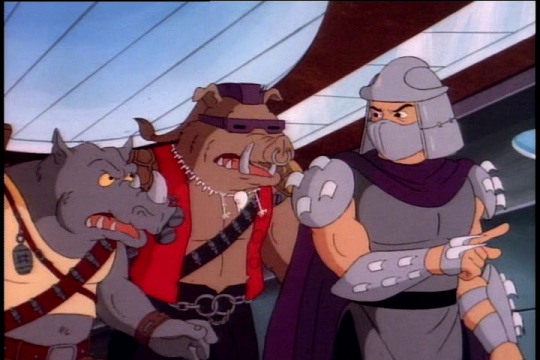
Krang goes on, explaining that Impervium is the hardest known substance in the galaxy. Unusually he doesn’t talk about using it to power the Technodrome, and instead enthuses about how he could use it to power all kinds of super weapons. Shredder doesn’t bother getting directly involved, leaving the task of getting the jewel to Rocksteady and Bebop.
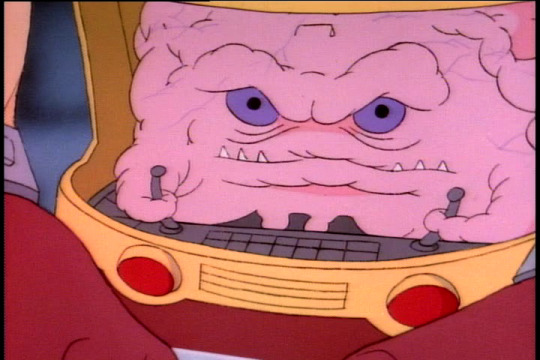
Later, in private, Krang talks to himself about how the substance is much more powerful than Shredder realises. He plans to use it to create a forcefield that will make him invincible.

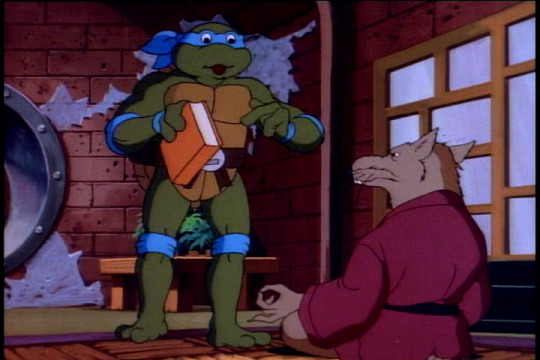
In the lair, Leonardo is enthralled by April’s copy of The Three Musketeers and won’t stop talking about it, to the frustration of the others who are trying to watch an old superhero movie on TV. Leonardo is discouraged by their lack of interest, and confides in Splinter that he’s trying to expose his team-mates to great literature. Inspired by their conversation, he contacts April and asks if she can procure four musketeer outfits for them.

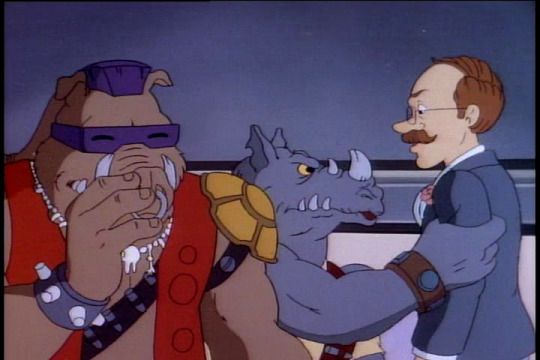


April and Irma are at the jewellery store where the Star of Brazil is on display when Bebop and Rocksteady barge in and announce their intent to steal it. After being alerted via Turtlecom, our heroes take their van and very quickly arrive on the scene. Leonardo obtains the Impervium jewel, but Rocksteady throws the stand it was on, clubbing him in the back of the head and knocking him out. In the scuffle, the jewel bounces out of the building and lands in a nearby trash can.

Back in the store, April’s outfit gets caught under a table. Irma manages to escape and after making it outside, spots the jewel in the trash. We can only assume she wasn’t paying attention during any of this as she believes someone genuinely threw it away, and wanders off with it.
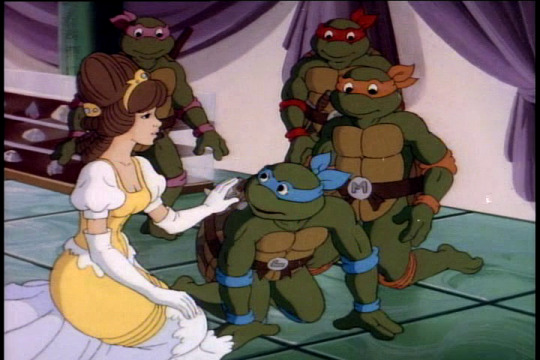
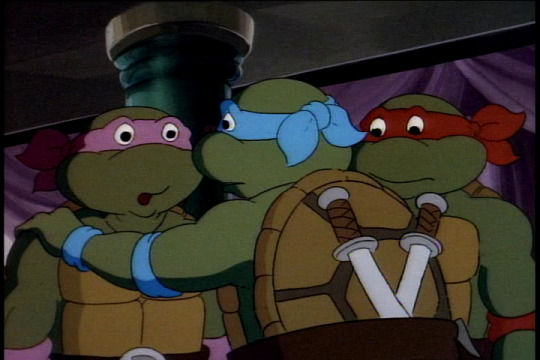
The Turtles attempt to revive Leonardo. When he comes around, the first thing he sees is April in her costume, whom he addresses as “Your Majesty”. Leo goes on to refer to Donatello, Raphael and Michaelangelo as “Artos, Porthos and Aramis” respectively before announcing that he’s d'Artagnan.
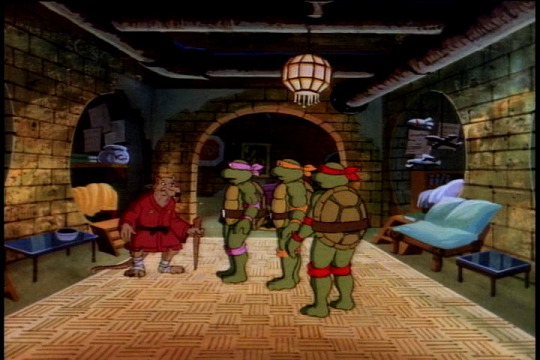
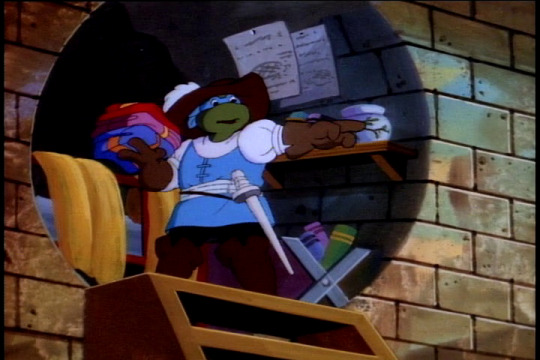
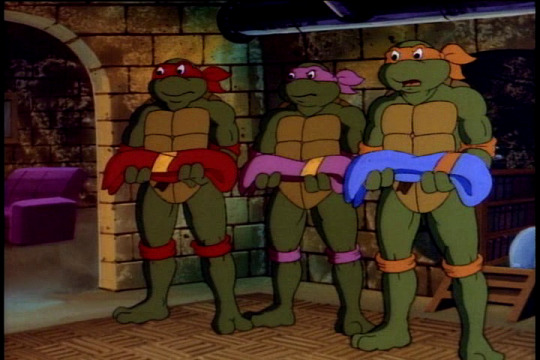

Our story continues after the commercial break with the other three Turtles and Splinter in the lair as Leonardo wakes up following his rest, now dressed in one of the musketeer costumes April provided. He goes on to provide the others with matching uniforms. Splinter insists this is a good idea as they “must humour him” until his memory returns. The other Turtles are very resistant to this and insist they won’t go through with it, before we get the classic sitcom wipe to reveal them doing exactly that.
vimeo
In the funniest moment of the episode, Leonardo assumes Splinter is their servant, and orders him to clean their lodgings “like a good fellow”. When Splinter is taken aback by this, Raphael throws his own words back in his face, reminding him that he said they must “humour him”. Raph silently tries to contain his laughter as Splinter complies. After being reminded about the stolen diamond, Leonardo charges off, convinced he made a vow to the Queen to “return her stolen jewel”.


Okay, the second funniest thing in this episode is the sight of Krang hurling a desk chair at Shredder’s head as he rages about Rocksteady and Bebop’s inability to obtain the jewel. In a little nod to the repetitive nature of the series, Shredder responds that he can’t be expected to travel to the surface every time Krang wants “some silly bauble”.

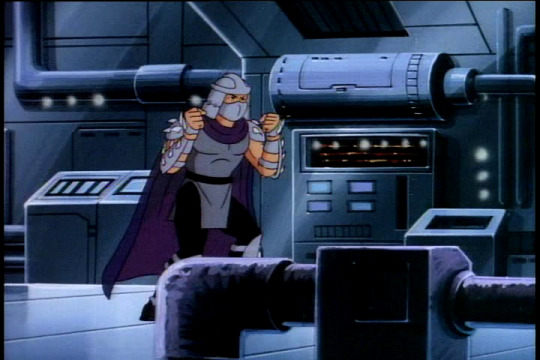

Krang reveals to Shredder he needs the jewel to create his forcefield. He gives him an ultimatum, telling him he has one more chance to get it. A seething Shredder stomps off, insistent that he won’t be taking any more orders, and planning a power grab of his own. Later, flanked by Bebop and Rocksteady, he secretly takes Krang’s new forcefield generator device and heads to the surface.

Irma is at home admiring the jewel that she now wears around her neck when Burne calls. He demands she show up at the parade to run a camera, and when she points out she’s a secretary, he threatens that if she doesn’t show, she’ll be neither. Hey, remember a few episodes ago when Irma appeared to be a stage manager instead of a secretary? It seems like this is a common occurrence. I guess Burne really does only have three employees.
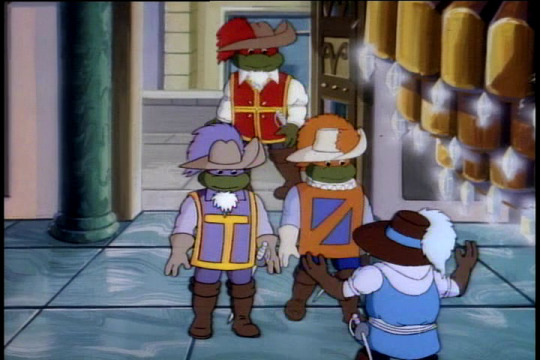
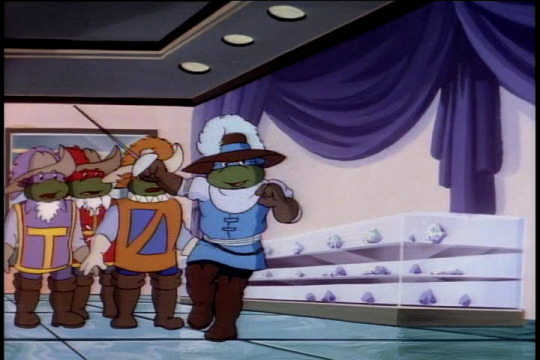
The Turtles take Leonardo back to the jewellery store, hoping it’ll help jog his memory, but instead he insists it’s where they fought the henchmen of Richelieu. He charges off, waving his sword in the air.
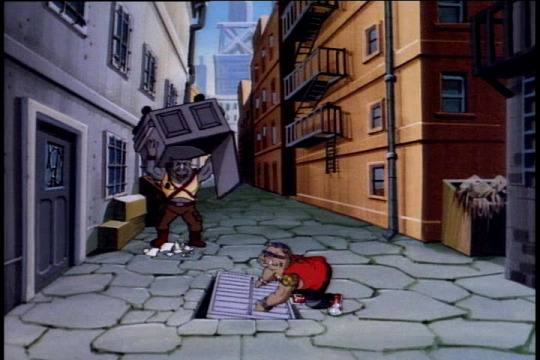
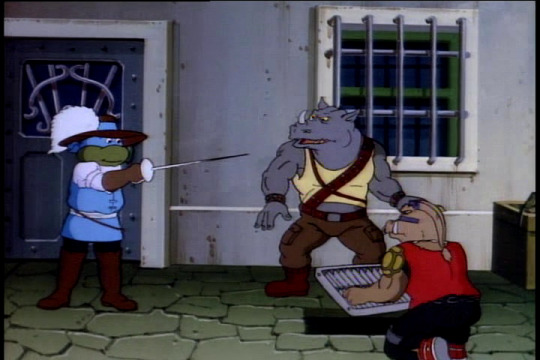
In a back alley, Rocksteady and Bebop are shaking down dumpsters in an attempt to recover the diamond when Leonardo confronts them. The henchmen assume he’s “one of them jerks from the parade”. He’s joined by the other Turtles, but the dastardly duo eventually escapes.
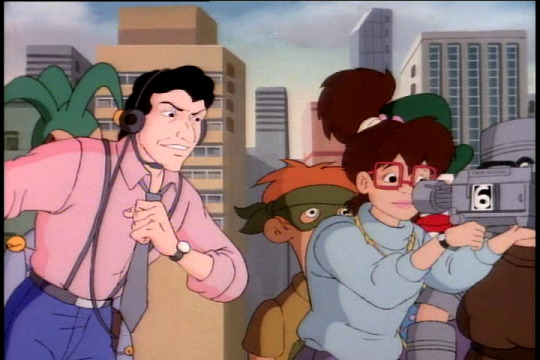
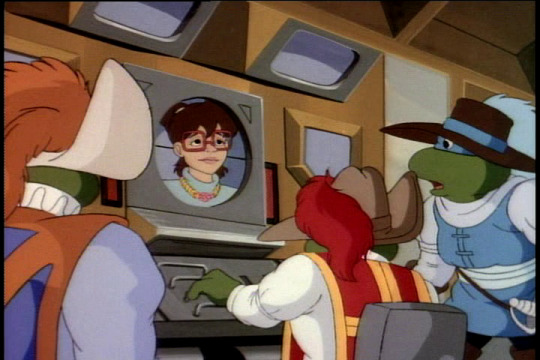
Still wearing the diamond, Irma is manning the camera (backwards) during the parade. Her image is picked up on TV and spotted by the Turtles as they drive through the city in their van.

Below ground, Krang becomes paranoid that Shredder will double-cross him. His suspicions are confirmed when he discovers that his forcefield generator is missing. He marches off with a group of Foot Soldiers, ready to strike back.
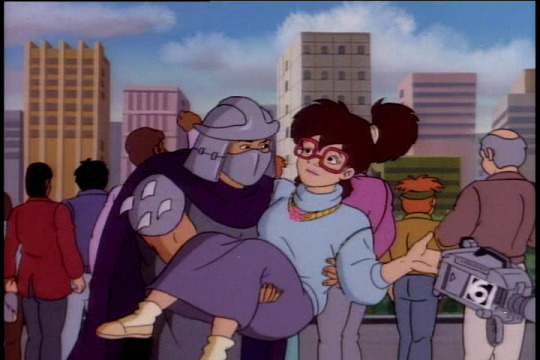
Irma runs into Shredder at the parade and compliments him on his costume, thinking he’s just a normal partygoer. Seeing that she’s sporting the diamond, Shredder scoops her up in his arms. Now completely distracted from her job, Irma carelessly discards the camera, which is heard off-screen hitting the ground with a painful thud.
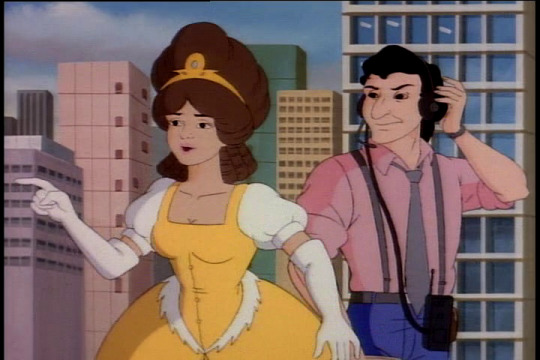
Still in costume, April spots Irma and rushes off to intervene. “Poor Irma?” declares Vernon. “How about poor him?”
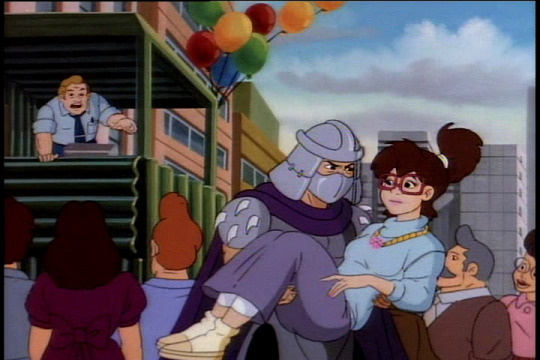
Burne spots Irma from a nearby booth and demands she get back to work. In a love-struck daze, she announces that she’s quit, and after everything we’ve seen regarding the way she’s been treated in this and previous episodes, I couldn’t blame her if she followed through with it.


Shredder is confronted by Leonardo, who believes he’s actually Richelieu. Correctly identifying him as being one of the actual Turtles rather than a guy in costume, he runs off, scaling a nearby float in the shape of an oil tower that forms a part of the parade. Leo is close behind, insisting he’ll rescue the “beautiful maiden”, which draws some less than complimentary remarks from Donnie and Raph.
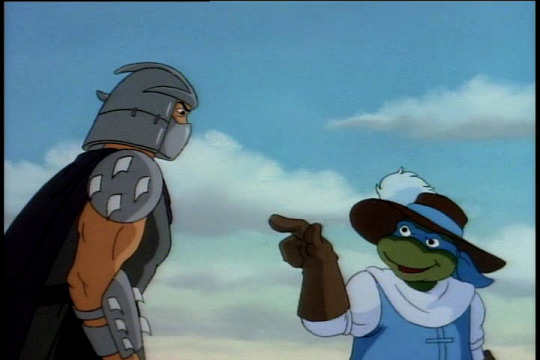
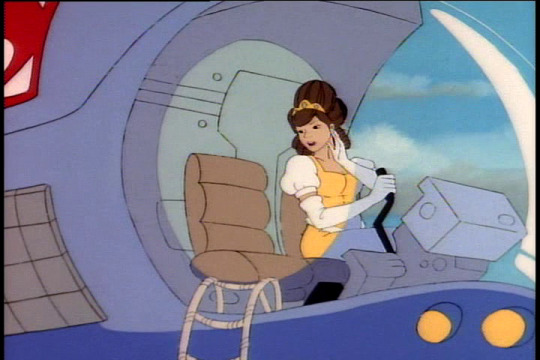
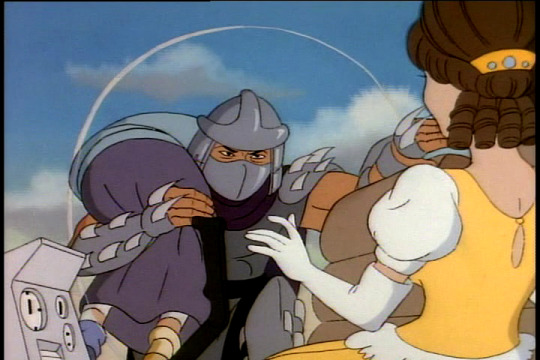
Leonardo and Shredder battle atop the tower while an elated Irma is thrilled to watch what she thinks are two men fighting over her. April commandeers a news copter to bail her colleague out of danger, but Shredder uses it as a means of escape, taking Irma, the diamond, and inadvertently both of his mutant henchmen with him.
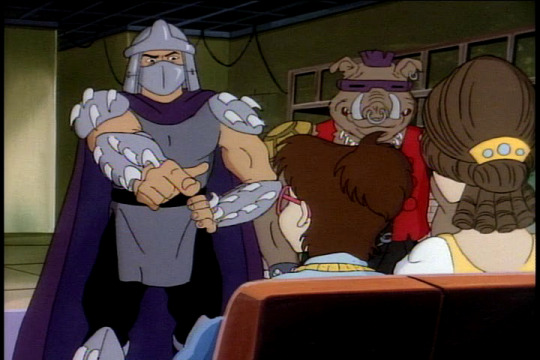
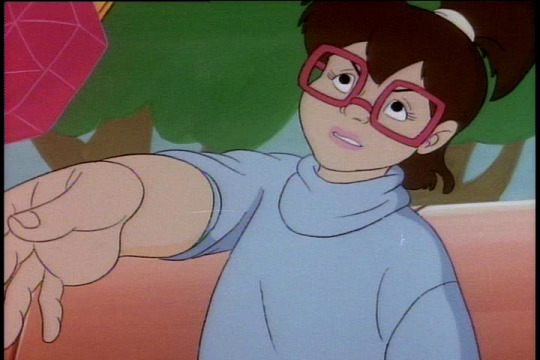
The helicopter lands back at Channel 6, where Shredder and his mutants dump both April and Irma in the basement. Irma is still under the impression that Shredder is interested in her romantically until he laughs in her face and explains he’s only interested in her diamond. Furious, she hands it over, declaring that “if that’s how you feel, it’s all over between us!”


Back in the lair, the Turtles are despondent at having lost April and Irma. Still believing he’s d'Artagnan, Leonardo is unfazed by everything happening around him, which finally causes Raphael to snap. He confronts Leo, who chortles in his face, and only shows a glimpse of his old persona when he briefly is able to correctly identify April’s face on TV.
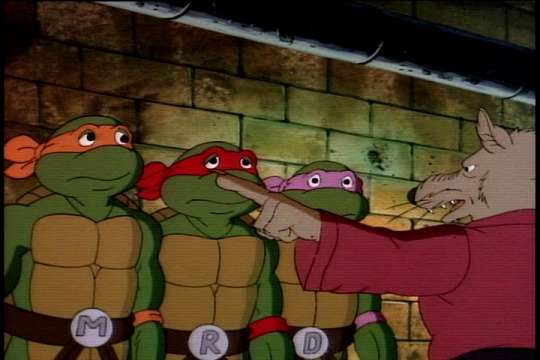

Leonardo takes offense when the others push him to remember his true identity. He marches off, and Splinter reminds them he needs to discover the truth for himself.
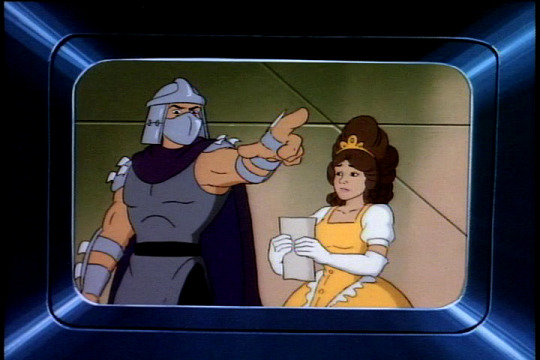
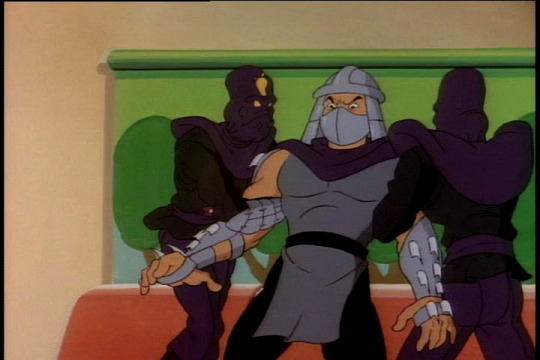
At Channel 6, Shredder forces April to rehearse her announcement of him as “The new ruler of the entire world, Emperor Shredder”. The proceedings are interrupted by the arrival of Krang in a transport module, who orders a group of Foot Soldiers to “seize that traitor”.

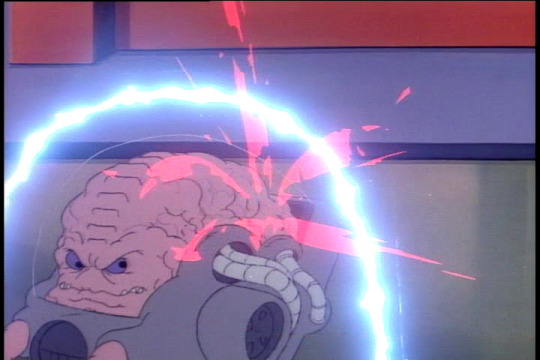
Shredder attempts to make his excuses, but Krang is unconvinced. He prepares to declare himself Emperor of the World, using the diamond to power his new forcefield. Krang orders Bebop and Rocksteady to attack him, but their attempts have no effect.
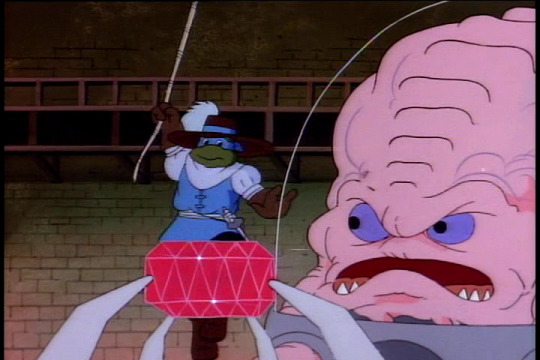
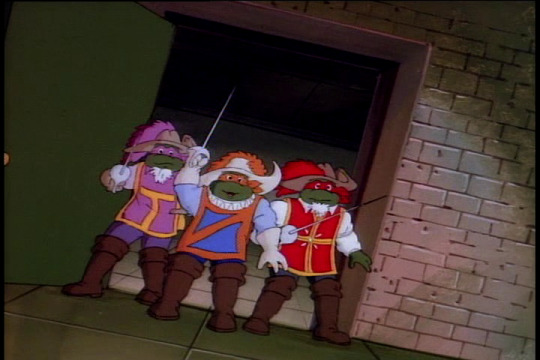
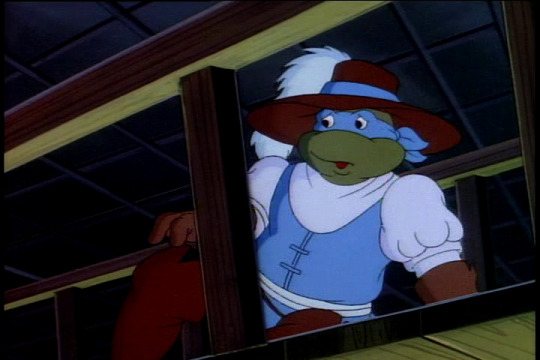
After Krang disables his forcefield temporarily in order to switch to his larger android body, Leonardo has an opportunity to sweep in via a rope and take the diamond. The impervium then winds up in Shredder’s hands after a laser blast from one of the mutants sends Leo falling backwards. Now back to his normal self, Leonardo comes around just in time to see the other Turtles hit the scene, and the four spring into action.
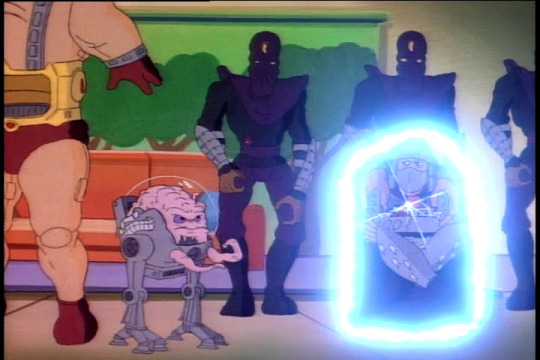


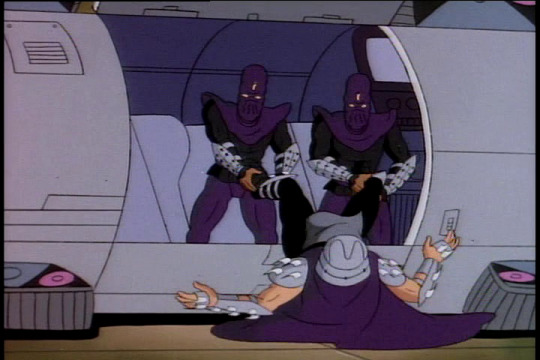

Shredder enables the forcefield generator himself, but finds himself squeezed into a tiny space as it was set for Krang’s dimensions. Leonardo picks Shredder up and briefly uses him as a makeshift shield. As the other villains flee, Saki is forced to disable the forcefield before he can leave with them; however, Donatello's bo staff trips him up, sending the diamond flying once more. It tumbles into a sink and down a drain, now lost forever.

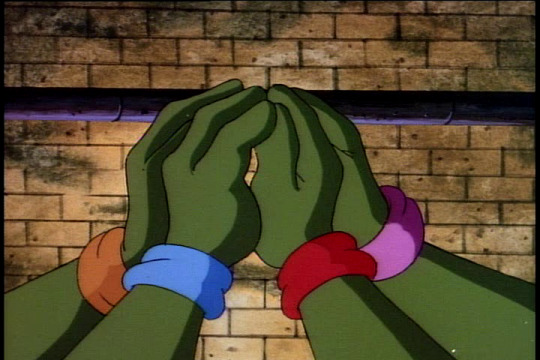
Later, in the lair, Leonardo laments that having lost the gem, all that fighting was for nothing. Splinter insists it was actually all for one, and one for all, which really doesn’t do anything to address the issue at hand when it comes down to it.
We’re missing a member of the regular cast again for this episode, as Greg Berg fills in for Barry Gordon as both Donatello and Bebop. Cam Clarke is on top form here as Leonardo, and this isn’t the first time he’s voiced the role of “d'Artagnan” (or at least his canine counterpart), as he was the lead in the English dub of Dogtanian and the Three Muskehounds a few years prior to Turtles debuting on TV.
youtube
"Four Musketurtles" has a premise that’s about as cliched as they come, but is actually a lot better than I remembered. Raphael, Irma and Vernon all have some genuinely funny moments here, and even the very fleeting glimpse into Krang’s past is something I appreciate. Not an essential episode by any means, but certainly a fun one.
NEXT TIME: Who can take your trash out? The garbage van can, in “Turtles, Turtles Everywhere”.
9 notes
·
View notes
Text










Mimi’s endless Ocs
Introducing Marvel Oc: Dimitri Shostakov
Face claim: Tom Hopper
Love Interest(s): TBD
Summary: Dimitri Shostakov was a shy boy that didn’t like to attract any attention to himself. The only one that could drag him out of his shell was his twin brother Alexei. The two brothers would take care of themselves and each other all the time, home alone while waiting for their father to return from his missions. Their father was the one and only Infamous Red Guardian, Alexei Shostakov. He was the greatest hero there ever was, at least to them and besides Captain America.
However, everything changed in 1991, they were five years old... when their father's Red Guardian uniform was taken from him. He could tell that his dad was depressed and just not the same as he was until a year later a man named Dreykov came and offered him an undercover mission. Dimitri didn't like or even trust him but wanting to feel like a 'hero' again his dad took up the mission.
Even though Dimitri had bad feelings about it, he and his brother were actually excited because they got to help their dad out with his important secret undercover mission in Ohio. What Dimitri didn't expect to see was a woman and two girls waiting for them. The woman's name was Melina Vostokoff, the oldest girl, who looked to be around 8 years old was Natasha Romanoff and the youngest girl's name was Yelena Belova, she looked to be around just 3 years old.
These girls would end up changing the little boy's life.
Dimitri and Junior's mother left very early on in their life, so early that they would never even know what she had looked like. The brothers only had each other and their father, but it was on and off. Melina was like a real mother to him, she was caring and understanding, more than his father really. Dimitri was considered to be a crybaby, weak. So, he had always felt like his father was disappointed in him, wanting him to man up, be strong like him and his brother. But, Melina seemed to understand his fear, always took him on walks when he was upset, explaining things to him that made him smile or curious. She even said that he was already a mini-scientist, always curious about things.
Being around Natasha and Yelena was amazing for Dimitri as well. He loved his twin, but he was always rough with him, picking on him. Natasha, however, always stood up for him, protecting him from anyone and anything. Then, Yelena was basically his best friend. They did everything together. He loved taking care of and having a little sister, one of their favorite songs was American Pie by Don McLean.
These would be the best three years of Dimitri's life...but it wouldn't last because, in 1995, his father completed the mission, and Dimitri was forced away from the mother and sisters he had grown to love.
Not only that, Dimitri was forced away from his twin as well, both would be used as experiments for the super-soldier serum. Dimitri ended up getting the worst of it. He was forced through painful treatments, eventually being brainwashed to follow their orders. Because of their experiments, it ended up mutating his body to become more giant and large, giving him an immense amount of strength.
Dimitri was only eight years old...
He would end up following their orders, killing whoever got in the way of missions for years, until he was 22 years old and his twin found what they had done to him.
Alexie, or Sasha as Dimitri used to lovingly call him, ended up freeing him from the brainwash and both tried to escape. Things ended up going horribly wrong, Widows were sent after the both of them and they were getting close. Sasha ended up sacrificing himself by causing a distraction so Dimitri could get away.
His brother survived, but was forced into a maximum prison because of his actions of the distraction he caused. Dimitri ended up running away, but getting cornered by a Widow, but during the scuffle, Dimitri ended up falling to his 'death'.
From the experimentation. Dimitri's body could receive an insane amount of injuries without dying like a 'normal' human being. However, the people who controlled Dimitri did not know this.
Dimitri successfully faked his death but had to hide underground for the next 8 years by himself, having only the company of plants and stray animals he took care of.
Until one day his brother came to rescue him with the company of his sisters he never thought he would see again.
And they needed his help...
Forever Taglist: @bravelittleflower @kendelias @randomfandomingwrites @eddysocs @jewelswrites-ish @raith-way
#mimi plot bunnies#mimi edits#oc: Dimitri Shostakov#i wrote so much for him...#but like i couldn't stop#marvel oc appreciation#marvel oc edit#marvel oc#mcu oc appreciation#mcu ocs#mcu oc#black widow ocs#black widow 2021#ocappreciation#allaboutocs#fyeahmarvelocs#marvelocsdaily#marveloccommunity#my edits#my ocs#mimi ocs#dimitri shostakov
47 notes
·
View notes
Text
Man of the House | three
Sam Wilson/fem!Reader, dark!Bucky Barnes/fem!Reader | 18+
A racket in the attic leads to a discovery of old memories. Your dissatisfaction leads you to a forgettable night.
► warnings(!): dubcon/noncon, asphyxiation. this is a dark fic.
|| Series Masterlist ||
A/N: This is it, lads. We’re picking up steam. And sorry for the delay, but I’m here to finally deliver. Thank you for the love lately on this story!

𝔻𝕒𝕪 𝕊𝕖𝕧𝕖𝕟
The pitter patter of rain was a welcomed presence. They added to the serene ambience of the residence; sombre but comforting. While others would bemoan the absence of sunny days, you relished in the cool and comfort it brought. It gave ways to days under duvets and blankets, a book and warm drink in hand. Today, it brought coolness to the sweat as strands of hair clung to the temples.
Napkin in hand, you wiped the respiration trickling down your chin, the cool air helping it dry off. Scanning the guest room, you were satisfied with the result. Floors mopped, surfaces wiped, sheets aired; the room was finally dust-free, perfect for accommodating guests.
Today marked the first week of your stay in the house. Your first week in the so-called haunted house. And one more week to go before you bag that $500 cheque. Take that, Tony.
Sam had left for the day, spending time with his college buddies at a bowling alley. He’d promised to cook you dinner when he came back, you looked forward to it.
The room was silent as you went back to work, stretching the sheets end to end, taut enough that a coin could bounce. And if the coin fell, hitting the floor, you were sure its ring would echo. The silence of the house when alone was deafening, saved for the small shower outside.
Suddenly feeling unsettled by the silence, you took out your phone. Opening your playlist, you played the first song you saw; Love by Nat King Cole. The music blared from the tiny speakers, flooding the room with the harmony of jazz.
You swayed and tapped to the beat of the cymbals, the saxophone aiding your show, all the while managing other meagre chores. You moved, feet light, across the hallway to the linen closet, taking extra sheets.
While fitting the sheets in the other guest room, that’s when your ears picked it.
Tap. Tap. Tap.
Among the symphony of rain and Nat King Cole’s swing baritone, you heard it; light footsteps, tapping to the rhythm of jazz, above you. The rain and sax almost drowned it out, but you could discern it between the others.
You stopped your hands and listened on. The creaking was light but they were there, following a rhythm of sorts. It took you seconds to realize the steps were not random. They were following the rhythm of the music.
They were dancing.
You let the music continue playing before it ended and changed to another track: Iron Maiden’s The Trooper.
The creaks stopped abruptly when Bruce Dickinson’s shout came through. Then, a sudden crash boomed your eardrums. Loud and heavy, like hardbound books falling off a shelf. It stilled for a moment before frantic meowing began.
“Peaches?”
The meows continued, high-pitched and desperate. You heard scuffling on the ceiling, probably the cat’s paws scratching the surface, desperate for help.
When the meowing went on for longer, you hurriedly left the room all the while huffing about the mischievous cat that you decided to keep. Pulling the built-in ladder at the end of the hall from above, you began climbing up. Peaches’ cries still echoed.
Your footsteps caused dust particles to float, making you hack. Taking the space in, you noticed every single item was covered in white sheets, protecting them beneath. Some were tall, some broad, crowding the attic in a ghostly maze. A lone circular window laid ahead, opened, flooding the supposed dark space in natural light. A breeze from outside came through, chilling you.
It was serene, yet a little unsettling. If one didn’t know better, they would’ve mistaken the standing figures to be ghosts, instead that of a lamp. Standing still in a few corners, unmoving. The fluttering of their sheets by a draft the occasional movement.
The feline’s constant whining reached you, pulling you out. You took slow deliberate steps, stumbling and navigating through the sea of cloaked figures. Paying attention to the pleading mewls, you tracked down Peaches to a corner, adjacent to the source of light.
“Were you prancing around up here? How did you even get up here?!” you scolded. Peaches whines only became louder.
Going over to the window, you shut it, stopping the cold air from chilling further. Strange, has it always been opened?
You stepped towards Peaches and assessed her.
She was covered in soot, immaculate white coat now stained grey. The cat, for some reason, got her tail stuck under something heavy; a large leather bound book, covered in an inch of dust. You picked up the offending item, freeing Peaches from her confinement.
“There you go, you stupid cat,” you huffed. She mewled in reply, head butting your leg, showing gratitude. “Yeah, next time pay rent.”
She slinked between your legs before dashing off down the stairs, her tail between her legs. You could only sigh at her mischief.
Gazing down, you inspected the heavy book in your hands. The word “Memories” was embossed on the cover in gold lettering. Some of the skin had been chipped off, the leather worn with age. Flipping to the first page, you realized it was actually a photo album.
A black and white portrait of a woman greeted you, her tight-lipped smile stern yet warm. She was a classic beauty, with shoulder length curls and immaculate brows. She looked every bit of the word professional.
Margaret Carter-Rogers, 1921-2016
On the next page, a wedding photo surprised you. In the photo, the woman —Margaret— was clad in virginal white. She was holding the arm of a light-colour haired man, whom you recognized to be Mr Rogers. He was equally dashing.
Carter-Rogers’ Wedding, June 1946
The following pages showed bits and pieces of their lives. Snapshots of the couple dancing; Five Year Anniversary, 1951. Photos at parties; Sharon’s First Birthday, 1977. And pictures with friends; Peggy’s Farewell Party, 1991.
You observed as the couple became progressively older with each flip of a new page. Hair became greyer and thinner. Skin became taut and wrinkly.
The photos of the couple stopped when you’ve reached a new section.
James Buchanan Barnes, 1917 -
The page showed a small photograph of a brunette donning what seemed to be a military cap. Sharp cheekbones and a cleft chin were his distinguishing features, but what caught your attention were his eyes. Light-coloured in the sepia hues, most probably a light blue. They crinkled with his smile, adding more to the charm.
To say he was handsome was an understatement, he was most probably a heartthrob during his prime, you imagined.
Flipping through each page, you uncovered more of the past. Each photo consisted of both Mr Rogers —a skinnier younger version of him— with this mysterious man. James, as you’ve learned to memorize.
There were photos from their youth; Coney Island, 1937. Stills in their uniforms; Leaving for Europe, 1943. Images from their military days; Howling Commandos, 1945. And they ended there.
You admired each one of them, curious about Mr Rogers’ friend. They seemed to be really close if the amount of photographs were of any indicator.
Where was he now? Were they still friends?
What piqued your interest further was the absence of a death date on the first page, beneath his photo. Was he still alive? If so, that would make him over a hundred. Where were the rest of the photos? The amount seemed considerably smaller compared to Margaret’s. Did something happen?
Before you could spiral further, you chose to close the album. That was enough prying for one day.
—
“Hmmph harder!”
Moans mixed with the slapping of skin against skin echoed in the bedroom. You were on all fours, clutching the comforter for dear life as Sam railed you from behind repeatedly. Your toes curled in time with the delicious sting from his girth, wanting more and more. The roughness of his palms kneaded your behind, slapping your globes occasionally. It filled him with satisfaction when they bounced to his thrusts.
The post-dinner activity commences.
“Ah... yeah, yeah, yeah.”
“You nearly there, baby?”
“Need more, Sammie,” you whined, head clouded with lust.
It started with a nice little dinner. Just the two of you. Before Sam brought out the whipped cream for desserts. He couldn’t resist.
Without warning, he flipped you over. You laid on your back, watching Sam as he hovered above. Giving a small peck to your lips, he re-entered, pistoning as he picked up where he left. You locked your ankles behind his back as you clung to him, the speed jostling you.
You could feel it. You could feel how close he was to climax. The sloppy thrusts. The harsh grip. The unbridled groans. He was close. But you weren’t.
Pumping a few more times, Sam stilled, lost in the pleasure of his release. Riding the wave, he looked at you.
“Did you cum, baby?”
“Nu-huh,” you admitted, pushing your hips. It had been pleasurable, but you were far from reaching your high. You wiggled your hips, enticing Sam and making him groan.
Starting again, Sam changed condoms and thrusted into you; the goal of sending you into an orgasm in mind. He slowly rocked into you, penetrating with shallow thrusts before picking up momentum, going deeper. The speed and angle was adequate, but you felt something was amiss.
Grabbing his arms, you thought of an act that would surely send you over the edge.
“Choke me, baby.”
You placed his palm on the base of your throat, closing the fingers on the sides of your neck. You gripped his hand, squeezing it to initiate the action. Immediately, you felt your airways cut off. The dizziness sent you to new sensations. A different kind of high that you welcomed.
You felt pleasure starting to build up within you. His deep thrusts paired with the asphyxiation drove you closer. Starting to tither over the edge, closer and closer. You were so close. Until it suddenly stopped.
You swallowed large gulps as oxygen invaded your lungs. The high that you were experiencing came crashing down, and not in the way you expected. You were robbed of it too early. Too soon.
Sam’s hands were no longer on your neck. You looked up at him, seeing unease and guilt and another emotion. Put off.
“I’m sorry, baby,” he apologized. “I’m just uncomfortable by it. What if I made a mistake?”
He apologized a few more times, but you admonished him, reassuring that it was okay. He tried to get you off one more time, reaching his second climax for the night. You never reached yours.

𝔻𝕒𝕪 𝔼𝕚𝕘𝕙𝕥
Sunday came around with a ball of sunshine to make up for Saturday. You spent the afternoon alone, again, serving lunch for one. The only form of company the cat you adopted, when it was not out causing mischief. It seemed your choice of dwelling has caused you further isolation than you realized.
You’ve always cherished being by your lonesome. But today, it felt particularly lonely.
The press of his lips on your forehead still lingered in your mind. The hug that he left with fell short of the usual warmth. Sam had been gone since breakfast, citing a friend needed his help. You didn’t ask further, giving him his space.
After last night, you felt it. His apprehension rolling off in waves. You didn’t blame him. While chasing for pleasure, you neglected the comfort of your partner. You neglected to discuss any boundaries that he had erected.
You’ll make up for it when he gets back. But before that, you had tea and cakes with Wanda to catch.
—
“I think it put him off,” you sighed. “Just this morning, he was doing his usual thing. He kissed me before he left, but it felt… different. Or maybe I’m looking too much into it and it’s actually nothing.”
The Sleeping Cat was crowded in the late afternoon. Its cozy interior provided shelter for those seeking warmth from the chilling autumn wind. The aroma of cakes and coffee was a welcomed presence, filling you with familiarity. Opposite of you sat Wanda, listening to your woes as she lazily stirred her tea.
“I feel bad, I told him to do it without discussing it with him first. He must be disgusted, or weirded out, I don’t know,” you gazed down, picking the strawberry on your cake. It was easy to talk to Wanda, she had always been a great listener, and a trusted friend. If anyone was an expert on relationships, it would be Wanda; Vis and her’s eighth anniversary a few months shy.
“Then, why not talk to him?” she said, looking quite amused yet still serious. “From what I gather, he only apologized. He didn’t say he was disgusted or anything. Like you said, it might actually be nothing.”
“Vis and I used to have misunderstandings a lot in the early years, given how clueless he always is,” she rolled her eyes. “But we learned that what we needed was to communicate. We’re not mind-readers, witch or not.”
You hummed, acknowledging the truth in her words. You’ve known Sam for a long time, friends before feelings came into the equation. You knew he would be open to communication; he did it for a living at the VA. It could end up actually being nothing but a misunderstanding from your part. It was silly. You’ll never know and keep on guessing unless you ask.
“Maybe you’re right,” you grabbed the tea at hand. “I was already thinking of making up to him, but maybe what we need —what I need— is just a conversation. Like a heart-to-heart.”
The tea soothed you, it’s blend of passionfruit and orange zest proved a tangy balm for your flurry of emotions. This company, and this atmosphere was a part of what you needed. On one hand, you shot Sam a text, asking if he’d be back for dinner.
“So, how’s the house? Feel like leaving yet?” Wanda asked, eyebrows raised.
You looked up from your phone, chuckling, “It’s been great, actually. Tony asked Sam if I wanted to bail out the other day, I told him to suck it.” Wanda laughed, amused, before her expression schooled.
“Have you experienced anything? Like, anything... weird?”
You contemplated her words, chalking it up to the usual suspicion. Your earlier intentions were to humour her, but the more you stewed, the more you were reminded of the past few days.
“Well, there has been this ‘screeching’ noise?” you said, unsure. “It happened at night, but not every night. Sam said it was the brakes of old cars passing by, but honestly, it could also be my cat.” You didn’t want it to be a cause for worry, you tried to deflect the topic as best as you could.
“I adopted a stray in the area,” you explained. “Her name’s Peaches and she’s a menace. I’ve found her down in the basement twice and yesterday, she was in the attic of all places!” you huffed, eye-rolling. “But yeah, nothing really exciting besides my stupid cat.”
Wanda chuckled. A few beats passed before she continued, “But if anything happens, promise me you’d let me know?”
Her eyes were unwavering, the greens intense. Her amusement had turned sombre. You knew Wanda saw the world differently than you did. Believed in it differently than you did. The least you could do was ease her mind.
“I promise you’ll be the first person I’ll call, Wands.”
—
It was nearing 12am and Sam still wasn’t back. Did he go back to his own place? You’d understand if he did, you had work yourself. But he’d told you if he were.
You furiously tapped the end call button, irritated at the repeated tone of the voice message. His last text read at 7pm, said he was meeting with Tony and Rhodey for a while and he wouldn’t be back for dinner. That was 5 hours ago.
You couldn’t help but worry a bit. Was this about last night? Was he upset? Was he mad at you? Was he avoiding you?
Putting the kettle on the stove, you turned on the burner. Remembering Wanda’s words, you thought of ways to calm your speeding mind. Some tea could help. After all, chamomile was considered a mild tranquilizer.
While waiting for the water to boil, you calmed yourself and thought rationally. Sam Wilson was a grown man. He didn’t need to be checked on constantly, didn’t need to be coddled, and he was deserving of his own personal space. You held yourself back from texting Tony and Rhodey, reminding yourself to respect Sam’s time and space. He will come back. He always does.
The whistle of the kettle broke your train of thought. Taking a tea bag from Mr Rogers’ box of a housewarming gift, you let it steep before bringing a cup upstairs.
The pull of slumber was immediate as soon as you finished; teacup barely making it to the saucer.
—
Creek!
You stirred from slumber, head groggy. The bed dipped and shook lightly, a weight rocked you slowly. Your eyelids felt heavy, unable to open, as if they were glued shut. Your limbs felt like lead; dense, laying useless by your side.
Creek!
With the absence of sight, your sense of hearing heightened. After a few beats, you soon realized what was creaking. It came from the frame of the bed, its wood rickety from age.
Cold air kissed your lower regions, making you shiver. You didn’t remember sleeping without the covers. Your nightshirt the only article of clothing, riding up until your stomach.
Creek! Creek!
Soon, a warmth enveloped you. A heavy weight. A body. Covering your form in their heat. They were running hot.
Calloused and roughened, two large hands descended on you, running your sides. Their fingertips and palms ghosted, barely touching, before stopping on your thighs. The sensation left you in a shiver, leaving a sense of yearning.
“S… S-Sam?” you croaked out, throat parched.
Blind and in a haze, you tried to move your arms again, wanting to reciprocate the touch. Wanting to feel him. Only your fingers twitched, the effort proved exhaustive.
Creek! Creek!
“Ah…”
A finger fiddled with your nub. He played with your clit, swirling with the pad of his fingers before gliding along your lower lips, prodding and teasing. He parted your legs, granting easier access as he toyed with your slit. Slick began to pool, he gathered and smeared it all over your cunt, giving your clit the occasional flick.
You felt cold and wet when he retracted, your juices clinging to your skin. Without warning, you felt the tip of his cock probed you, snuggling into your tight channel, demanding entrance. His thick girth stretched you, making you feel full. He gripped your thighs, holding you in place as he began rocking, plunging into you bit by bit.
You felt odd. You swore one of his hands felt colder than usual. You shivered.
Creek! Creek! Creek!
The bedframe squealed louder and louder as he picked up speed, fucking you without a rhythm. You felt empty when he pulled out and full when he rammed in. He jostled you, hitting all the spots that made you scream, lost to the euphoria. You felt the occasional tap to the cervix, his bulbous head kissing it repeatedly.
And while all this was happening, you remained locked, limbs laying heavy and unmoving.
Creek! Creek! Creek!
You loved the feeling of him inside you. You took him in like a champ, body pliant and receiving everything that came your way. The sensations made you almost forget your state of inebriation.
With one hand, he pulled your nightshirt above your chest, freeing your breasts for him to see. The cold air hardened your nubs slightly. It wasn’t long before you felt a warm tongue descend on your tit, swirling and suckling as if to fulfill a hunger.
He gave them both equal amounts of attention and care, alternating between the two. He stopped when he felt the treatment was adequate, leaving your nipples sore and wet in saliva.
Creek! Creek! Creek!
Fighting the heaviness, you slowly tried unfolding your eyelids. It proved exhaustive. You managed a tiny slit, shutting when it felt too much.
Your field was blurry and dark, heightening your hearing as the bed continued to creak. Sam’s broad figure hovered above, plunged in darkness. You couldn’t make out any features, just the shadow of his movements, thrusting into you.
Creek! Creek! Creek! Creek!
You felt a hand on your neck. Slowly, he began enclosing your throat, cutting your airways like the night before. Except this time, he didn’t stop squeezing.
The deep penetration of his cock combined with the exhilaration of breath play sent you to new heights. A new feeling; dizziness, euphoria, pleasure all rolled in one. The lightheadedness pushed you forward, nearing the edge. You felt it in your core.
Creek! Creek! Creek! Creek!
His pubis kept rubbing on your swollen clit, adding to the amounting high. His movements were getting erratic. He was getting closer, and so were you.
He released your throat, letting a rush of oxygen fill you. You were sent to an all new high. This was it, another type of rush. The head-spinning exhilaration you’ve been waiting for.
“S-Sam!” with a loud rasp, you came undone, quivering beneath him. He followed suit, jacking his hips frantically before stilling. His loud groan reverberated, almost animalistic in the night.
Tired out, your eyelids weighed down again, never getting the chance to peek at him. You drifted off, sleep pulling you under before you could hear his low mumble.
“Your fella could never do that, could he?”
#sam wilson x reader#bucky barnes x reader#dark bucky barnes#marvel fanfiction#dark fic#horror#mystery#bucky barnes fanfiction#sam wilson fanfiction#smut
80 notes
·
View notes
Text
Burned alive: How the 2014 Odessa massacre became a turning point for Ukraine
Eight years ago this Monday, something significant happened in Odessa, a historically important city in the southwest of Ukraine. Although the West didn’t see it as such, for Russia and the newly formed Donbass republics, what transpired there became a symbolic episode.
Provincial revolution
From late 2013 into early 2014, a conflict between the government of President Viktor Yanukovich and the pro-Western opposition was unfolding in Kiev, the capital of Ukraine. The series of events that would ensue were dubbed the ‘Euromaidan’. Meanwhile, Odessa, a port city on the Black Sea, was of course affected by these events too, albeit to a lesser extent.
Occasional clashes with police and scuffles between supporters of Euromaidan and those aligned with the government, which became known as the ‘Anti-Maidan’ movement, were nothing compared to the bloodshed in Kiev, where people were being killed.
Many Ukrainians didn’t welcome the Euromaidan, and they had their reasons. Lots of Odessa residents had strong ties with Russia, and still do. When Ukraine gained independence in 1991, a large number of ethnic Russians were living in Odessa and many had relatives in the old country. The city was built during the reign of Catherine the Great and has always been seen as an integral part of Russia’s history.
Thus, the aggressive nationalism of Euromaidan was largely unpopular there and plenty of locals were frightened by what seemed to be a passion for forming militant units. Euromaidan and Anti-Maidan in Odessa began to form parallel paramilitary organizations. Armed with a primitive array of sticks, biker helmets, and homemade weapons, these groups trained for street fighting. At first, nobody sought a fight to the death – the radicals hadn’t yet gained the leading role in either movement.
In Odessa, Anti-Maidan activists had begun gathering at Kulikovo Field, a square near Odessa’s House of Trade Unions in the city’s historical center. This became the site of an ongoing protest – it could also be described as a forum in the classical sense. People came to hang out, discuss the news, and even sing together. It was a very diverse crowd, from energetic youngsters to the elderly. Those who assembled there weren’t officially united by any specific ideology. One could run into Russian Orthodox activists, Cossacks, and a number of smaller groups.
The movement was led by local pro-Russian and leftist politicians, such as activist Anton Davidchenko and his brother Artyom. Their demands were very moderate – to protect the Russian language, grant the eastern regions economic autonomy, protect Russian and Soviet historical heritage, ensure monuments weren’t vandalized, let the East elect its own judges, etc. But Ukraine was in turmoil, and this program seemed extremely confrontational to the nationalists.
On the third of May 2014, after Yanukovich had already fled to Russia and Moscow had reabsorbed Crimea, Vladimir Nemirovsky, a nationalist politician, became head of the Odessa Region. He intended to harshly crack down on any form of protest. Dispersing the Kulikovo Field camp was a key point in his platform.
People hold up flares as thousands of Ukrainian nationalists, veterans and local residents march to commemorate the 2014 clashes between pro-Kyiv and Russia-backed groups on May 2, 2021 in Odessa, Ukraine. © Pierre Crom / Getty Images
Tensions had been gradually rising throughout March and April. After an armed uprising broke out in Donetsk and Lugansk, Euromaidan activists set up checkpoints on all roads leading to Odessa. Nobody knew who or what they were guarding, but about 500 people, not all of whom were even from Odessa, manned these very strange checkpoints. At the end of April, Nemirovsky announced that ‘Territorial Defense’ units, which are essentially military reserves, had been bussed into Odessa.
‘Territorial Defense’ buses were arriving in the region at that time. A lot of them. We tried to keep them away from Odessa whenever possible, but they went to Belgorod-Dnestrovsky and other places. They spread throughout the region. They were coming from the direction of Kiev. The police stayed away from them, the officers were demoralized.”
Even back then, these nationalist units were dangerous. They were arming themselves: we know of at least one case when a Euromaidan activist accidentally blew up a hand grenade. Molotov cocktails were also manufactured at these checkpoints.
Anti-Maidan found itself in a difficult situation. The initial excitement was winding down. There was a feeling that the struggle against the nationalists had been lost and nobody wanted to take a step toward violent conflict. In fact, the Kulikovo Field camp would have disappeared on its own in a few weeks. The Anti-Maidan leaders were already discussing the subject with the local authorities. They had even reached an agreement to shift it from the city center to the World War II memorial, which is in a less central location. The move was scheduled for May.
However, a less peaceful transition was also in the works. Though the police and governor didn’t want to get their hands dirty, there were enough ‘volunteers’ willing to take matters into their own hands. A football match against a team from Kharkov, a city in northeastern Ukraine, was scheduled for May 2, and Odessa was flooded with radical football fans. Rumors of potential violence began to circulate in April, and the Anti-Maidan activists had reason to be concerned about a possible raid on their camp. Some anticipated the future clashes with fear, others with excitement, but everybody knew that the Anti-Maidan camp would be destroyed. It was a perfect solution for everyone, except the activists themselves.
While rebels took over one city after another in the Donbass, and people in Crimea enthusiastically welcomed the Russian military, an easy victory for the nationalists in Odessa would give them the opportunity to demonstrate their strength. It would also allow the governor to show that he had the city under control. At this point, though, nobody was thinking that what was going to occur would take a lethal turn. A few Anti-Maidan activists wanted to remain in the central part of the city. Their idea was just to intimidate the nationalists.
On May 2, the football fans were to march through Odessa to the stadium under the slogan “for unity in Ukraine.” Euromaidan activists declared that this was to be a peaceful demonstration, but adherents of Anti-Maidan were convinced that the march would just be a cover for violent tactics.
Early in the morning of May 2, Sergey Dolzhenkov, the leader of the Anti-Maidan security group and a former police officer, contacted a member of the local parliament to request that the march be canceled:
“People saw what happened in Kharkov, Kherson, and Donetsk. The football fans were out of control. We need to make sure there is no bloodshed. No march – no bloodshed,” he said.
“I was on Kulikovo Field on May 1, and Artyom Davidchenko {the leader of Anti-Maidan in Odessa} announced from the stage that Right Sector {an ultra-nationalist Ukrainian organization whose name has become synonymous with all Ukrainian nationalists} was coming to town, and they would destroy the Kulikovo Field camp. We have to fight them off,” remembers Maxim Firsov, an activist from the left-wing Borotba movement.
Dolzhenkov and his Anti-Maidan group had limited forces. Officially, there were a lot of people at the camp, but the majority were women and elderly, who would not be able to fight. In fact, they themselves needed to be protected. That’s why Dolzhenkov decided to accompany the march with some of his men, while keeping a distance. Not everybody in the Anti-Maidan camp liked this plan, but Dolzhenkov was a man of action and thought it was better to meet the opponent head on and block them if they decided to walk toward the Kulikovo Field camp.
The police and Ukraine’s Security Service knew what was afoot but had no plans to interfere. On May 2, Artyom Davidchenko met with both agencies and was informed that detentions and arrests would start only when there were dead bodies, and there “would definitely be bodies.”
On May 1, activists from both groups were anticipating a fight, but nobody expected what actually happened.
Fighting on Grecheskaya Street
On the morning of May 2, an off-schedule train took around 500 Kharkov football fans to Odessa. Along with them, there arrived Pro-Euromaidan groups having nothing to do with football but who were armed with street fighting equipment, including personal armor and weapons. In the afternoon, they began to gather on Cathedral Square in the center of Odessa.
An Anti-Maidan group 150-to-300-strong departed from Kulikovo Field, which is about a 30-minute walk away. Although vastly outnumbered by the 2,000-3,000 Euromaidan fighters and fans, Dolzhenkov guided it in the direction of Cathedral Square anyway.
The Odessa police refused to intervene in the events. Its main forces of around 700 officers guarded the stadium, while around 80 followed the Anti-Maidan activists and 60 kept watch over Kulikovo Field. High-ranking police officers had been summoned for a meeting and were ordered to turn off their phones.
A small police unit tried to block Dolzhenkov’s group, but it simply circumvented the officers.
Meanwhile, an excited crowd had already gathered on Cathedral Square armed with clubs, shields, helmets, Molotov cocktails, and rubber-bullet handguns.
At around 3 pm, the Anti-Maidan activists from Kulikovo reached Cathedral Square via the adjacent Grecheskaya Street. Many accounts describe the arrival of Dolzhenkov’s group as an all-out assault resulting in a breakthrough. This is often referred to as an Anti-Maidan attack on the ultras. At first glance, a group of 300 charging a mob ten times its size would appear to be folly. But if you scratch the surface, new details emerge.
Some football fans saw the Anti-Maidan activists approaching and engaged them. The actual fight was initiated by two small groups of Dolzhenkov’s men and a crowd of Euromaidan activists. The main contingents did nothing at first, keeping their distance, but this was enough to spark the conflict.
With a thin line of police officers between them, at first the sides threw stones at each other. But the numerical advantage of Euromaidan was overwhelming and Anti-Maidan was quickly put on the defensive. Most of the officers were facing the Euromaidan side, which was throwing bricks, stones, and Molotov cocktails. The police began firing air and rubber-bullet guns almost from the beginning.
For Euromaidan, the altercation on Grecheskaya Street was amusing but accomplished nothing, so some activists went to the parallel Deribasovskaya Street on a flanking maneuver. This is where the first real blood was spilled.
The fight was already on when the Anti-Maidan supporters began shooting their firearms. A Euromaidan activist and nationalist named Igor Ivanov was killed by a bullet. He was likely killed by Kulikovo activist Vitaly Budko (Boatswain), who had arrived at the scene quite late – around 4 pm – with a civilian rifle, and opened fire as soon as he joined his companions. Neither he nor his weapon was ever found in the aftermath, and information on the bullet that killed Ivanov disappeared from the police database. However, several videos and photos show him having been firing his weapon before himself being shot. Another Maidan activist was shot dead with an air gun.
Anti-Maidan protesters soon came under fire too, and some were wounded. The subsequent investigation was conducted so poorly that none of the guns involved in the shootout were identified afterwards. There is footage of at least one injured protester.
The fighting went on for several hours. Reinforcements periodically came to bolster the Euromaidan activists, and they soon blocked all approaches to Grecheskaya Street. The Kulikovo group found itself surrounded at the Athena shopping mall, while well-coordinated Euromaidan teams were cutting off any reinforcements or avenues for retreat. Around 4 pm, the Euromaidan side captured a fire engine and drove it into a small barricade the defenders had built. Around 5:30 pm, a group went out onto the balcony of a nearby building and opened fire on their adversaries. Bullets and pellets extracted from the bodies revealed that at least three guns were involved. Four men died instantly, and several more were wounded, including a journalist, a police colonel, and a couple of officers. The defense crumbled. Some retreated to the shopping mall, barricaded themselves inside, and eventually surrendered to the police. Among them was Sergey Dolzhenkov, who had suffered a bullet wound. It seemed as if everything was over.
Death by fire
The Maidan activists had essentially already won the battle. The Kulikovo Field activists were defeated. By this time, people were simply roaming around aimlessly. Some sports fans from the stadium had joined the commotion after the game ended. But events were about to take a completely different turn.
Mark Gordienko, one of the leaders of Odessa’s Euromaidan movement, was one of those who began shouting, ‘Kulikovo!’ encouraging the crowd to go to the site where the Anti-Maidan protesters had put up their camp. In March of 2014, he was known to have said that he “would shoot down all separatists.” That day, he had an opportunity to fulfill his promise. Later, he seemed to have conveniently forgotten that he had spearheaded the violence.
Gordienko and a number of others managed to reignite the cooling crowd. Later, a recording of a conversation between Odessa Deputy Mayor Igor Bolyansky and one of the Euromaidan commanders was leaked, during which Bolyansky not only suggested that the commanders lead the crowd on the 30-minute walk from Grecheskaya Street to Kulikovo, but even discussed the logistics of how this should be done. In other words, this wasn’t a case of a crowd spontaneously moving in a certain direction but of one being steered there by leaders who made sure it arrived at the destination.
Meanwhile, the people at Kulikovo were confused and disoriented. Most were civilians with no military training whatsoever, and they weren’t particularly keen on participating in any battles. There were many women among them. Artyom Davidchenko had already briefly told them what had just transpired, while some people who had managed to escape Grecheskaya Street returned to give them a run-down of events. Many who had been on the square had already gone home, yet a number of them returned when they heard a crowd was on its way to attack their camp and fellow protesters.
That’s why a sizable number of the protesters who ended up at Kulikovo knew an attack was coming. Someone suggested taking cover in the massive Trade Unions building on the square, and people began to move their belongings from the camp into the building. They set up an improvised first aid station there, brought in supplies and built a small barricade in front of the building. They also had a couple of hunting rifles and a few Molotov cocktails. Davidchenko then left the square. Aleksey Albu, a low-level local politician, stayed in the building. At the time, he was not the kind who would be eager to participate in any fighting. In fact, he had learned about the clashes from the news.
The Trade Unions House had around 300 people inside that evening.
At 7:20 pm, the angry Euromaidan crowd entered the square. They moved through the abandoned camp and started throwing Molotov cocktails at the barricade in front of the Trade Unions building. Those inside responded by lobbing a few Molotov cocktails back at the attackers from the roof. It was then that a reporter who was filming everything said, “Now, they’ll definitely kill them.”
The attackers kept throwing rocks and improvised bombs at the barricade, which mostly consisted of wooden furniture and crates, and finally set it on fire. The protesters behind it retreated into the hall of the building. Later, many reports exaggerated the scope of the resistance put up by those in the Trade Unions building. Available footage shows that the attackers freely moved around the square, not needing to duck or take cover because there was no fire coming back at them.
The barricade was in flames and the attackers had set fire to the tents on the square. The whole square was full of smoke and flames. The attackers continued to hurl cocktail bombs filled with a home-made napalm mixture consisting of gasoline, acetone, and Styrofoam at the building. The holed-up protesters called the fire brigade, but no one came. The few policemen on the scene did nothing to interfere and just watched as the events unfolded.
The attackers made sure the fire didn’t die out, throwing more and more cocktail bombs into it. They even tossed in a burning car tire, while firing at the windows with anti-riot guns.
Then tragedy struck.
Independent expert Vladislav Balisnsky explained that the fire raging at the building’s entrance ignited the paint and varnish on the hall’s walls and ceiling. The burning entrance door collapsed, and the window panes were broken one by one by gunfire, creating a powerful draft. The resulting chimney effect turned the central staircase into a huge incinerator, with temperatures at the center rising to 600–700 degrees Celsius. The fire spread nearly instantly and everything that could burn was consumed in the fire. The people in the vicinity were essentially burnt alive. Others tried to save themselves by taking refuge in rooms further from the blaze. The draft continued to pull large clouds of smoke down the building’s corridors, killing more and more people on its way.
That’s when people began to jump out of the windows, which seemed a better alternative than being burnt alive or suffocating.
But for some leaping turned out not to be the lesser of two evils. Those who jumped ended up injuring themselves badly, sometimes fatally. But surviving the hazardous jump did not mean the end of the suffering. One activist was captured on camera running up to a person who had jumped out of a window, injured by the fall but still alive and moving, in order to beat the victim with a baton. Later, local journalist Sergey Dibrov spent some time studying footage and images from the incident and concluded that the victim ultimately received medical assistance and survived.
It was at this point that some people in the mob started to feel remorse and tried to help those caught in the burning building. Some threw a rope to those on the upper floors. Others dragged scaffolding to the building to help those trapped inside escape. These acts helped quite a number of people get out of the building alive, although some emerged only to be beaten on the ground. The last cocktail bomb was thrown into the building at 8:08 pm. The police reinforcements finally arrived and pushed the most belligerent attackers back. The fire squad arrived at 8:15 – despite being stationed just 400 meters away, it took them 30 minutes to arrive on the scene – and started to rescue the last survivors.
As it turned out, quite a lot of people survived the fire. The havoc subsided, and the fire squad and police restored order. Some people had been rescued from the roof, while others were found in rooms untouched by fire or smoke. The last survivors, who had been hiding in the attic, left the building in the early hours of May 3.
Elena was among those from the Kulikovo Field camp who had helped set up the first aid station before the attack. Later, she told reporters that she had been harassed by the people outside after escaping the fire. They shouted insults at her and even roughed her up, while the police paid no attention at all. During the fire in the building, those on the winning side displayed quite contradictory behavior. Some made genuine attempts to save people from the conflagration they had just started, and even risked their lives to do so, while others were happy to take advantage of the opportunity to continue to assault and humiliate the survivors.
A total of 48 people died: two Maidan activists and 46 Kulikovo Field Anti-Maidan protesters – two on Grecheskaya Street, and 42 at Kulikovo Field Square. Eight people jumped from the building to their deaths, while others suffocated or died from burns. All were citizens of Ukraine. A total of 247 people requested medical help following the incident, of whom 27 had been wounded by gunfire.
Albu, the local politician and one of the leaders of the group, was among those who had taken cover in the building but survived. He later joined the LPR’s Prizrak Brigade in Donbass. Another leader, local MP Vyacheslav Markin, died the next morning from injuries sustained after jumping from the building to escape the fire.
Ashes
In the following years, not a single person responsible for the killings in Odessa was punished in any way. Many of the murderers acted openly, wearing no masks or disguises, and were very straightforward about their intentions. Only a handful even faced criminal investigation. But ultimately, not a single one was brought before the courts to answer for the crimes committed. Whatever hearings did manage to be scheduled were derailed by the so-called ‘patriots’. A number of judges were forced to recuse themselves from the cases after receiving threats from militants.
Meanwhile, high-ranking Ukrainian politicians were quick to identify the ‘culprits’. Ukraine’s acting President Oleksandr Turchinov said that the disturbances in Odessa “were coordinated from a single center located in Russia.” Sergey Pashinsky, acting head of the presidential administration, said that it was “an FSB provocation to divert attention from the [so-called] anti-terrorist operation [in the Donbass]”. Ukraine’s Foreign Ministry declared that “the tragedy was a pre-planned and well-financed operation by the Russian special services.”
From the very beginning, the authorities in Odessa seemed to deliberately obstruct the investigation. By the morning of May 3, the area around Grecheskaya Street had been cleared by municipal workers, who quickly disposed of all the physical evidence. The Trade Unions building remained open to the public for the following month. Citizens could watch live streams from the smoldering ruins, with one cameraman referring to the corpses of a young pair as “Romeo and Juliet.” No attempt was made to preserve the crime scene. The weapons used to kill people were never found. And these are just a few examples of the investigation’s dismissive and negligent attitude toward the case. In September 2015, UN Special Rapporteur Christof Heyns acknowledged that the bulk of the evidence relating to the May 2 events was destroyed immediately after the crime.
Euromaidan activist Sergei Khodiyak, who fired at people with a hunting rifle, was released from custody, and the judge recused himself from the case under pressure from a group of Maidan activists led by Igor Mosiychuk, an MP from the nationalist Radical Party. Vsevolod Goncharevsky, who used a club to beat and finish off Kulikovo activists who had jumped out of the windows of the burning building, was released due to a “lack of evidence.”
Dolzhenkov and a number of other Anti-Maidan activists remained in custody. In 2017, after many delays, the court acquitted Dolzhenkov in connection with the case. But he was immediately arrested again on the trumped-up charge of chanting illegal slogans at a political rally that had taken place a month before the tragedy. In December 2017, the last pro-Russian activists were released from custody as part of an exchange of detainees and prisoners from the Donbass conflict.
Ukrainian society reacted to the events in Odessa in a very peculiar way. Naturally, the majority of the population sympathized with the victims. Flowers would be brought to the Trade Unions building every year on May 2. The public realm and the media, however, were dominated by nationalists. For a few months after the events, social media platforms were overflowing with ‘jokes’ about the ‘Odessa barbecue’, the ‘burning of vatniks’ (a typical Soviet-era wool-padded jacket that became used to refer to Ukrainians espousing pro-Russian views and to Russians themselves), as well as slogans eerily reminiscent of those employed by Nazis about the Jews that they murdered in World War Two. The Ukrainian internet was flooded with pictures of burnt corpses accompanied by derisive comments. Many of the people who took part in the Odessa event soon thereafter ended up in the Donbass, fighting in the volunteer battalions of the Ukrainian army. “All it takes is to kill fifty ‘vatniks’ in every city, and then we shall have peace, then the war will end,” remarked Maksim Mazur, a member of the Aidar Battalion – a statement that was eagerly endorsed by many of those who had attacked people in Odessa.
In fact, Ukrainian social media did exactly what is commonly attributed to Russian propaganda. The piles of burnt corpses evoked feelings of horror, but also of rage. May 2014 was a breaking point: volunteers from Russia started to arrive in the breakaway republics en masse and even some men from Western Europe came to fight on their side. Slogans about autonomous status and the need to engage in talks with Kiev gave way to an unwavering resolve and determination to stand and fight to the bitter end. Just a few days after May 2, a Donbass rebel wrote on a destroyed and burned-out Ukrainian infantry fighting vehicle: “This is for Odessa, you bastards.”
The voice of those who were horrified by the events from the very beginning and understood what had really happened was simply not heard. But they were probably worth listening to. Two years later, Artem Sushchevsky, from the Donbass town of Makeevka, wrote:
“I can repeat all I want that not everyone is crazy and that most Ukrainians are still the good and sensible people they always have been. I’m convinced this is true, and I’m not contradicting myself by saying this. But there’s one ‘but’: these good and sensible people can live peacefully with the events that transpired on May 2 in Odessa, already two years ago. And they also somehow live with the shelling of Donetsk. And in general, they have to put up with this shameful war, consoling themselves with fairy tales about a Russian invasion. But I can't live with those who can live with this. I don't care how I live – as long as it's not with you.”
Alexander Topilov, an Odessa musician and Euromaidan supporter, wrote a few days after the tragic events:
“…there were boys born in 1994. There were young girls, university professors, mechanics. I don’t know. Not all were quick enough to jump. Not all survived the landing. It’s not a victory, like hell it is! Don’t cheer us. I saw some exalted comments. Who the f*ck wants a victory like that? And who can even call it a victory? That’s a f*cking fiasco. It’s civil war. Odessa residents at each other’s throats. Who’s the winner here? I don’t need victories like that, the f*ck I do. Some people are like animals and some beasts are humane, that’s what I’m talking about. The line between ‘us’ and ‘them’. I lost mine on May 2. I don’t know where to draw it. I see people. And I see animals. Animals on my side, people against me. So, what do I do next? Damned if I know, boyo, as they say on the other side… And there are not less real people there than animals here…”
That desperate cry fell on deaf ears. On the same day that the Trade Unions building was burning, there was intense fighting in Slaviansk in the Donbass. The Ukrainian army was trying to enter the city. Soon, the militias armed with a motley assortment of hunting rifles, handguns stolen from police officers and Molotov cocktails were replaced by battalions and brigades equipped with artillery and tanks. Eastern Ukraine quaked with the blasts of howitzers and the rumbling of tanks.
x
#odessa#odessa massacre#ukraine war#ukraine crisis#russian ukrainian war#russian ukraine conflict#crime against humanity#russia invaded ukraine#defense of europe
2 notes
·
View notes
Text
David Kato Kisule
David Kato is considered Uganda's first openly gay man.

He was a father of the LGBT rights movement in Uganda and a teacher.
David was born in 1964 in Mukono, to the Kisule clan in its ancestral village, he received the name "Kato" because he was the younger of twins.
He was educated at King's College Budo and Kyambogo University and taught at various schools. It was here that he became aware of his sexual orientation and was subsequently dismissed without any benefits in 1991.
He left to teach for a few years in Johannesburg, South Africa becoming influenced by the end of the apartheid-era ban on sodomy and the growth of LGBT rights in South Africa.
Coming back to Uganda in 1998, he decided to come out in public through a press conference; he was arrested and held in police custody for a week due to this action. He continued to maintain contact with pro-LGBT activists outside the country.
Kato became highly involved with the underground LGBT rights movement in Uganda, eventually becoming one of the founding members of SMUG on 3 March 2004.
Kato spoke during a November 2009 United Nations-funded consultative conference on human rights. During the conference, Kato spoke on the issue of LGBT rights in Uganda.Members of the Uganda Human Rights Commission "openly joked and snickered" during the speech.
A rumour circulated that David Bahati, the leading proponent of the Uganda Anti-Homosexuality Bill, had ordered the Inspector General of Police to arrest Kato, causing Kato and other attending members of SMUG to leave the conference immediately after he finished the speech. Bahati then made a "tirade against homosexuality" to the conference, resulting in massive applause.
By 2010, Kato had quit his job as a school teacher to focus on his work with SMUG. Kato was subsequently given a one year fellowship at the Centre for Applied Human Rights in the United Kingdom, a centre which provides fellowships to vulnerable and threatened human rights activists as a reprieve from the dangers they face in their own countries.
On 26 January 2011, Kato was assaulted in his home. Kato later died en route to the Kawolo General Hospital. Kato's colleagues note that Kato had spoken of an increase in threats and harassment since the court victory, and they believe that his sexual orientation and his activism were the motive for the murder.
Human Rights Watch and Amnesty International have both called for an in-depth and impartial investigation into the case, and for protection for gay activists. The Ugandan Minister declared that "Homosexuals can forget about human rights".
After being spotted in Mukono district Sidney Enoch was arrested and sentenced to 30 years with hard labour, on Thursday 10 November 2011. The apparent motive was robbery.
Present at the Kato's funeral were family, friends and co-activists. The Christian preacher at the funeral preached against the gays and lesbians present, making comparisons to Sodom and Gomorrah, before the activists ran to the pulpit and grabbed the microphone from him, forcing him to retreat from the pulpit to Kato's father's house.
An unidentified female activist angrily exclaimed "Who are you to judge others?" and villagers sided with the preacher as scuffles broke out during the proceedings. Villagers refused to bury Kato at his burial place. The task was then undertaken by his friends and co-workers.
The murder was decried by Human Rights Watch, with senior Africa researcher Maria Burnett adding that "David Kato's death is a tragic loss to the human rights community.
Barack Obama, US Secretary of State Hillary Clinton and the State Department, and the European Union also condemned the murder and urged Uganda authorities to investigate the crime and to speak out against homophobia and transphobia. "I am deeply saddened to learn of the murder," Obama said. "David showed tremendous courage in speaking out against hate. He was a powerful advocate for fairness and freedom."
Kato was interviewed for a documentary film on his life, Call Me Kuchu, which premiered at the Berlin International Film Festival.


31 notes
·
View notes